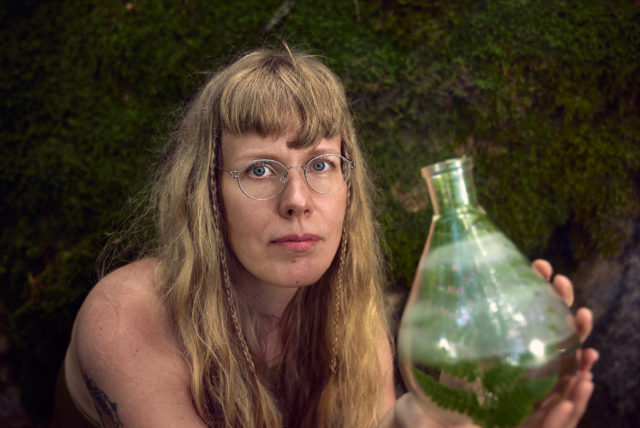
Elsa Salonen
In the early 2010s, Elsa Salonen developed a technique in which she distils colours from flowers, leaving them pale and colourless. The extracted colour pigments the artist preserves in various ways and displays them alongside the white flowers. The technique is based on a notion that most organisms, both in the plant and the animal world, seem to lose their colours in death – flowers wither and bodies blanch. Thus, all the colours in nature signal the presence of a living force. In Salonen’s three-dimensional paintings, the result is a poetic separation of the life energy (preserved colour) from its empty, pale body (decoloured flower).
For the last decade, Salonen has painted exclusively with natural pigments, which define the conceptual message of each work. She prepares the pigments for her artworks by grinding a wide variety of raw materials, such as meteorites, animal bones and seashells, as well as by extracting colours from medicinal herbs, mushrooms and algae. Each material holds unique knowledge. Salonen views the pigments as collaborators whose individual ‘experiences’ define the conceptual message of the artwork. Through the self-collected materials, many of the themes connect to a certain natural site around the world, wherein the more universal themes are addressed with unique materials collected with the help of specialists.
Salonen’s practice draws on the traditions of painting, installation, and conceptual art. The works are marked by the artistic interpretation of alchemy, which explores the universe through natural materials, and animism, especially the Finnish nature worship. What alchemy and animism have in common is the perception of all surrounding nature as living and sensing. In Finnish nature worship, each natural environment is believed to be governed by a sprite that guards the region, influencing its well-being and prosperity. For the artist’s ancestors, maintaining a balanced relationship with these nature sprites through offerings was essential for ensuring good hunting, fishing, and harvesting.
In turn, medieval alchemists studied natural materials, which they also used to make colours. Through the materials, they sought to understand the surrounding universe as well as the interconnectedness of everything in the cosmos and the individual’s role among all others; oneself. The glass vessels Salonen uses in her works refer to this alchemical tradition and its illustrations. One of the most important steps in alchemy was repeated distillation, which left the purest essence of the substance – and the alchemist – in the glass flask.
_____
Elsa Salonen (b.1984, Turku, Finland) works in Berlin, Germany (studio location) and the Turku archipelago, Finland. Salonen’s art has been exhibited internationally with institutions including, KINDL Centre For Contemporary Art and Villa Merkel in Germany; Art Sonje Center in South Korea; Kunsthal Aarhus and Kunsthal Viborg in Denmark; Galleri F 15 in Norway and Miguel Urrutia Art Museum in Colombia. Her artworks are included in collections including Museum of Contemporary Art Kiasma (FI), Wäinö Aaltonen Museum of Art (FI), Saastamoinen Foundation (FI), and Lissone Museum of Contemporary Art (IT). A Permanent Public Artwork by Salonen is situated in the Quiet Room of Meilahti Bridge Hospital, Helsinki (FI). Salonen is represented by Galerie Jochen Hempel in Germany, Le Clézio Gallery in France and Ama Gallery in Finland.
Add to My FavoritesFeatured artwork
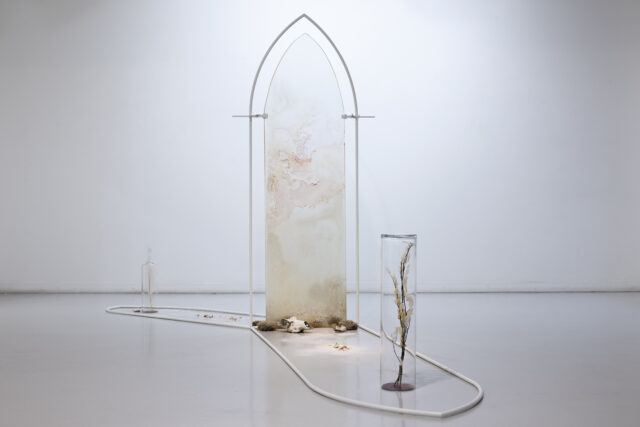
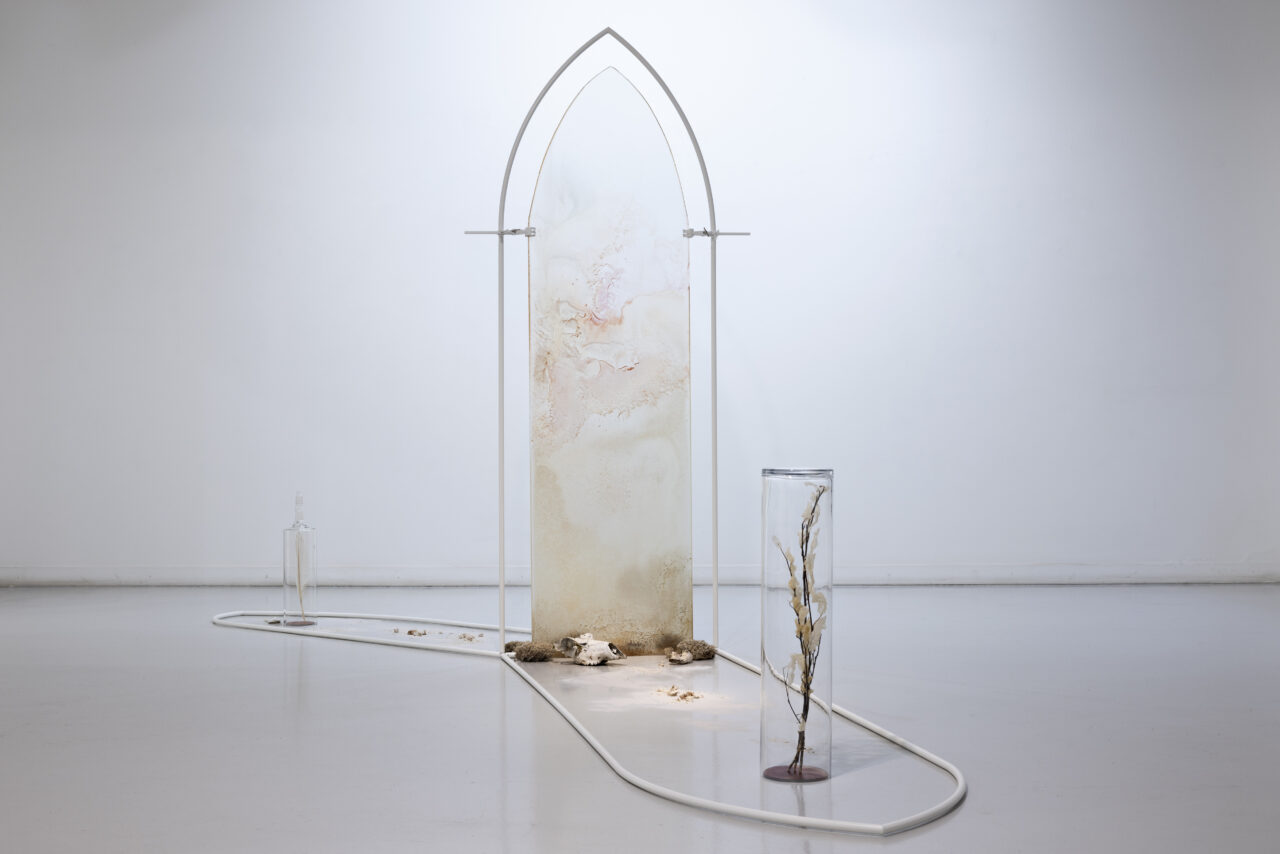
MetsänpeittoElsa Salonen, Metsänpeitto, natural materials collected from the Finnish forests (painting: colour pigments extracted from alder barks, spruce cones, moss and mushrooms on glass / installation: swan feather, tops of three alder trees, lichen, animal skulls, bones and teeth, powders ground from them and stones), salt, alum crystal, glass, metal (The installation Metsänpeitto focuses on the mythological powers of the forest, the fortress of the plant kingdom. In Finnish nature worship, metsänpeitto (lit. forest's cover/blanket) meant the disappearance of people and cattle into the forest's otherness: one did not get lost in the forest but drifted out of sight of this reality. This was counteracted, for example, by hiding salt in hollow bird feathers or, after Christianity had taken over the worldview of the Finns, by building barns in the same direction as the church. One way to escape metsänpeitto was to invoke the power of death or to tie the tops of three young trees together.), 215 cm x 175 cm x 415 cm ,2021-2024. Photo: LT.
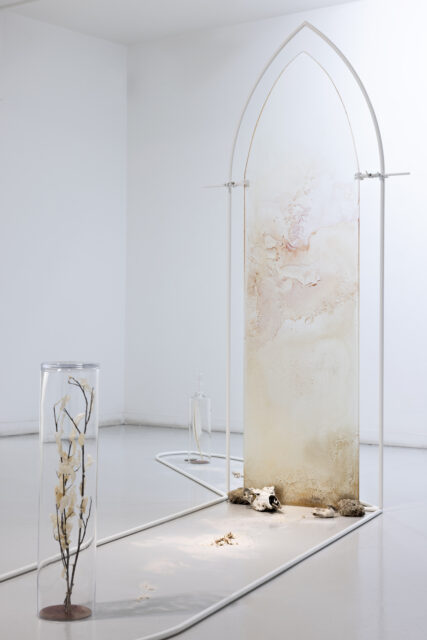
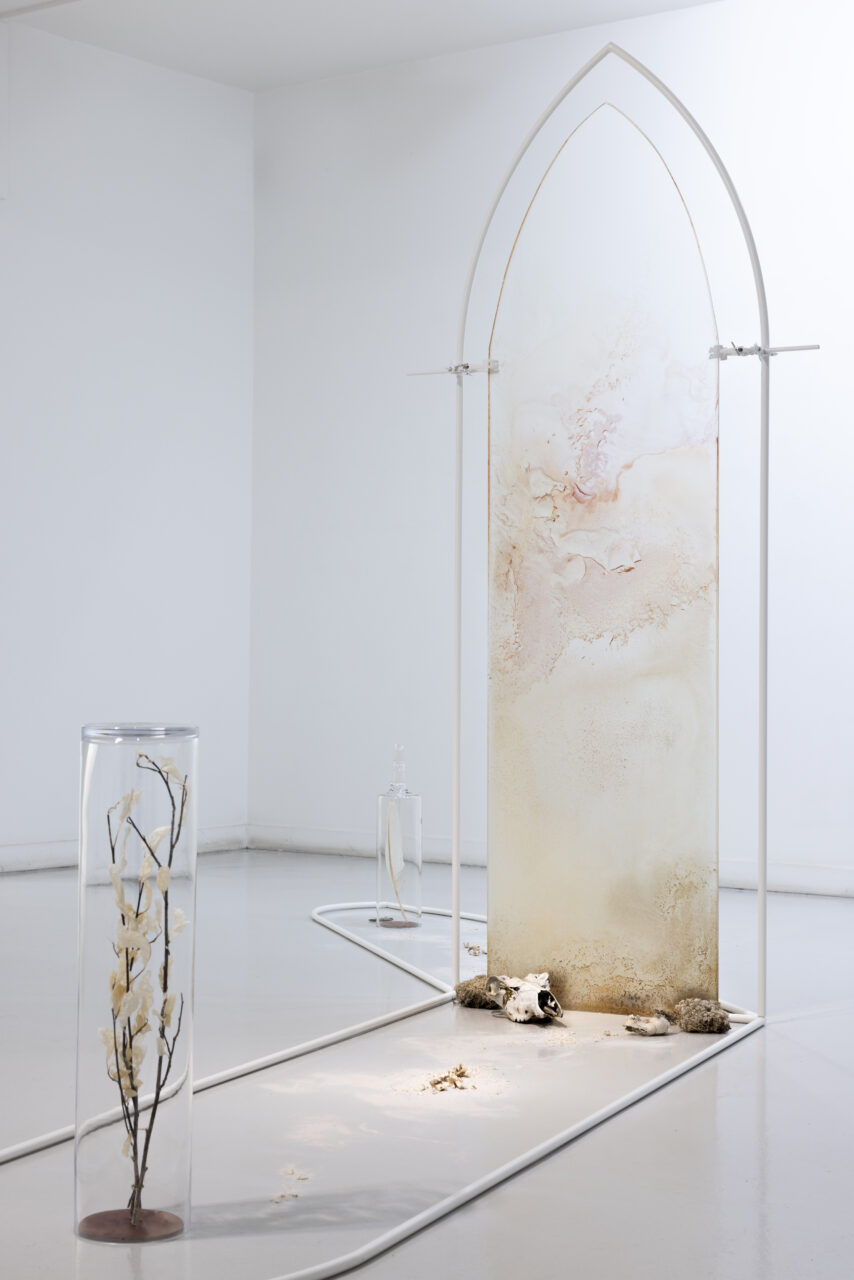
MetsänpeittoElsa Salonen, Metsänpeitto, detail, 215 cm x 175 cm x 415 cm ,2021-2024. Photo: LT.


Blue LullabyElsa Salonen, Blue Lullaby, colour pigments ground from stones, ashes burnt from reptile parts, bird parts and rosebay willowherbs, rainwater on glass, metal shelf (For the Lullaby paintings the artist, with the help of her family, collected sleep-inducing rosebay willowherbs, an abandoned bird's nest, feathers, a lizard tail and snake skin from the Finnish forests. Salonen burnt these materials into ashes. Using the ashes, pigments ground from mineral stones and rainwater, she painted on glass an image of a flask with a dragon resting inside on a bed of rosebay willowherbs. The dragons, familiar from alchemical illustrations and combining reptile and bird features, represent the union of this and the otherworldly, the earthly and the heavenly, or the journey between them. The sleep-inducing medicinal plants act as similar travelling companions between wakefulness and sleep. These different dimensions are also embodied in the colour pigments used in the paintings.), 45 cm x 30 cm ,2023-2024. Photo: LT.
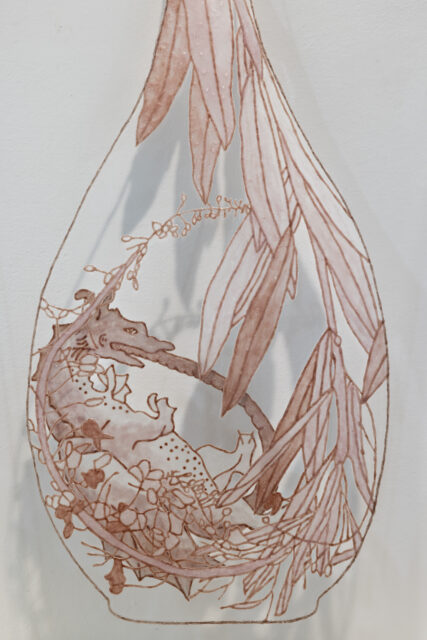
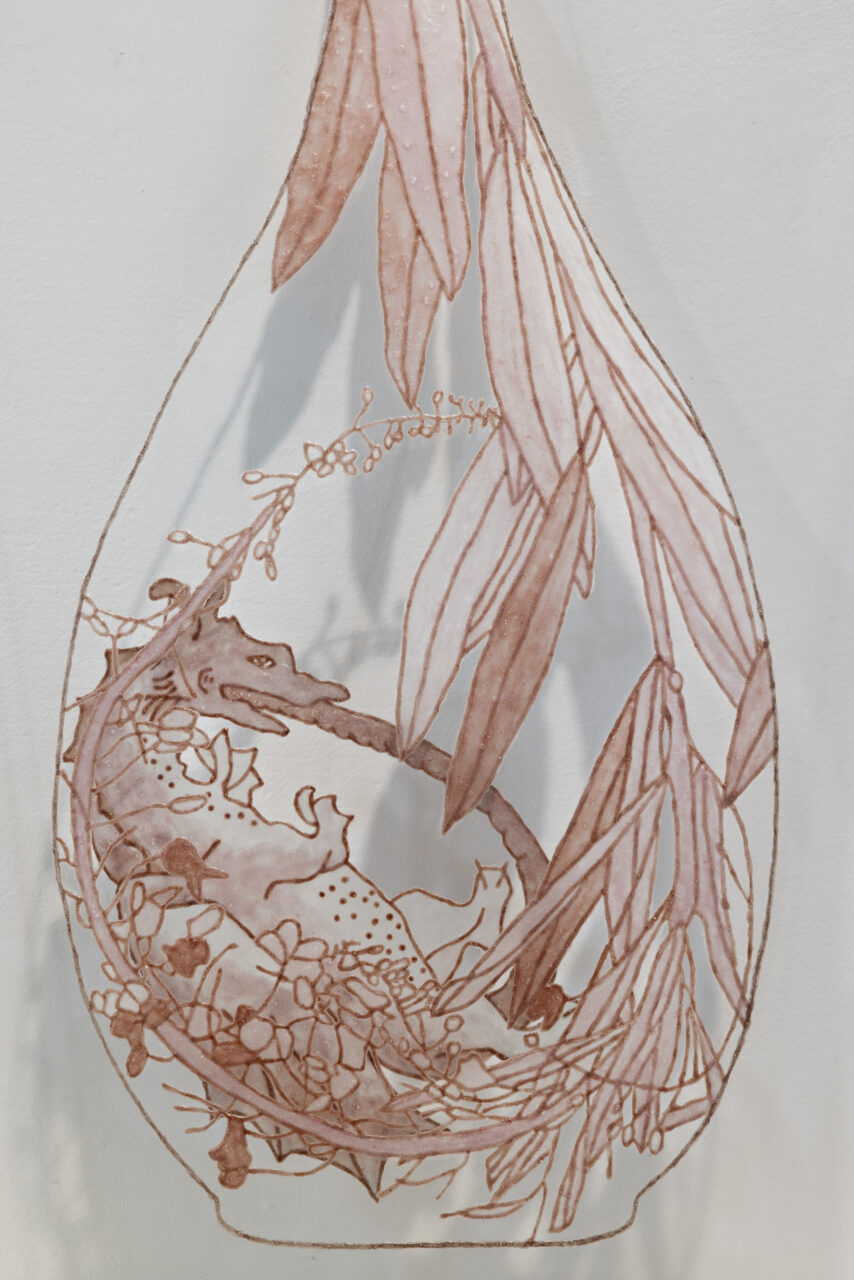
Pink LullabyElsa Salonen, Pink Lullaby, detail, colour pigments ground from stones, ashes burnt from reptile parts, bird parts and rosebay willowherbs, rainwater on glass, metal shelf (For the Lullaby paintings the artist, with the help of her family, collected sleep-inducing rosebay willowherbs, an abandoned bird's nest, feathers, a lizard tail and snake skin from the Finnish forests. Salonen burnt these materials into ashes. Using the ashes, pigments ground from mineral stones and rainwater, she painted on glass an image of a flask with a dragon resting inside on a bed of rosebay willowherbs. The dragons, familiar from alchemical illustrations and combining reptile and bird features, represent the union of this and the otherworldly, the earthly and the heavenly, or the journey between them. The sleep-inducing medicinal plants act as similar travelling companions between wakefulness and sleep. These different dimensions are also embodied in the colour pigments used in the paintings.), 45 cm x 30 cm ,2023-2024. Photo: LT.
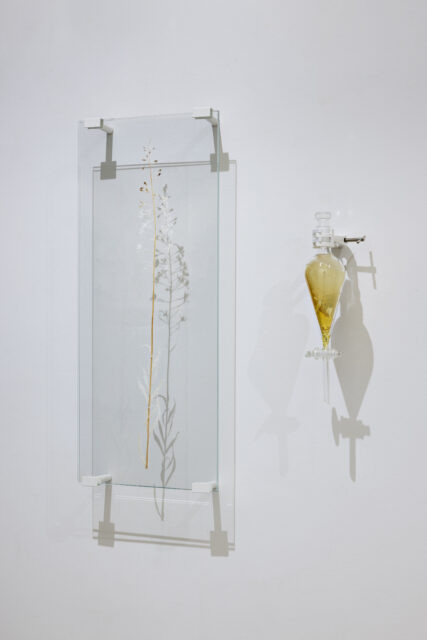
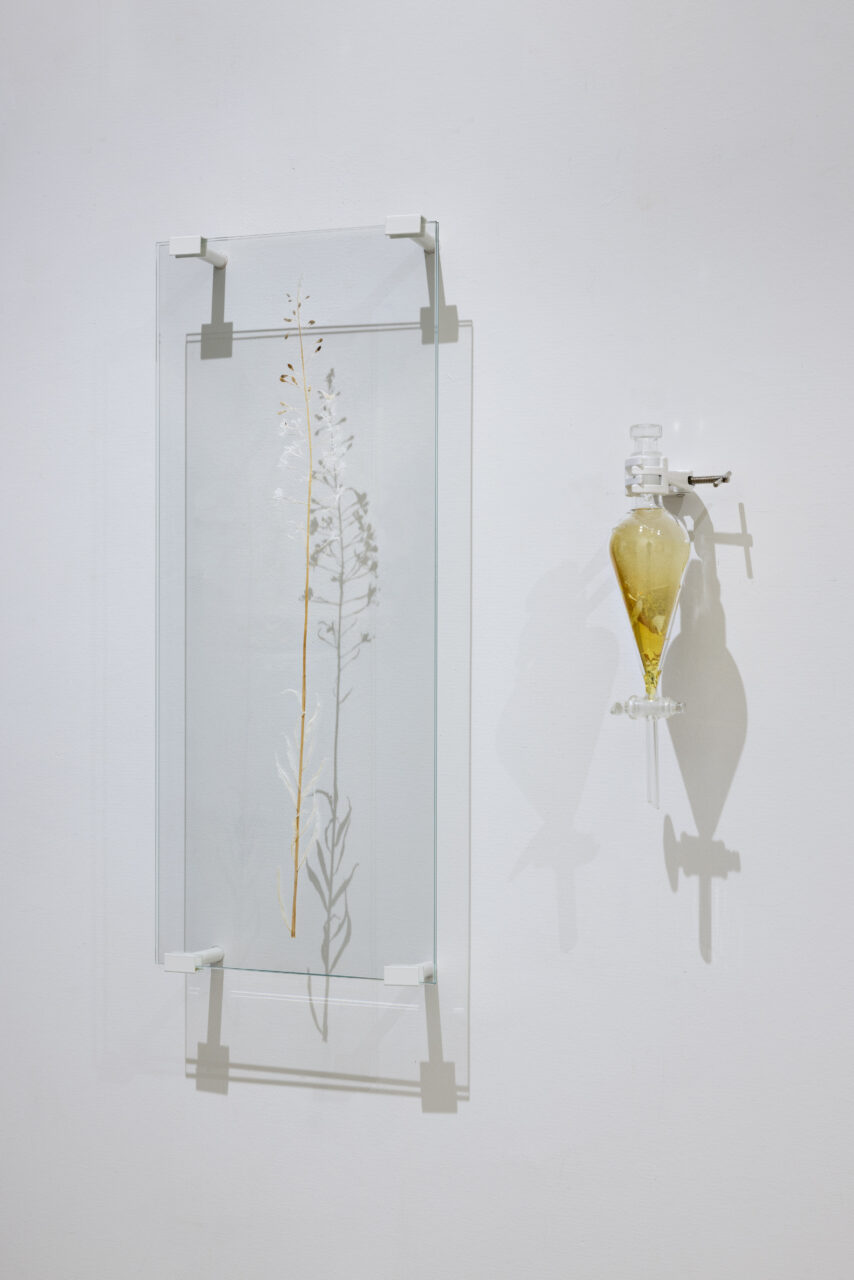
Plants, Healers: Deep Sleep (Chamaenerion angustifolium I)Elsa Salonen, Plants, Healers: Deep Sleep (Chamaenerion angustifolium I), sleep-inducing medicinal plants collected from Finland and Germany, colour pigments and medicinal substances distilled from the plants, isomalt, glass, metal (The series Plants, Healers: Deep Sleep consists of sleep-inducing medicinal plants that the artist collected over the course of two summers in her home region, the Turku archipelago, and around her studio in Berlin. Healers have relied on herbs for centuries. In the Finnish tradition of tietäjät (seers/healers), the knowledge of the required medicinal plant was often obtained from a sprite during sleep. An imaginative idea of interspecies communication through dreams is glimpsed in the works.), 60 cm x 25 cm ,2023-2024. Photo: LT.
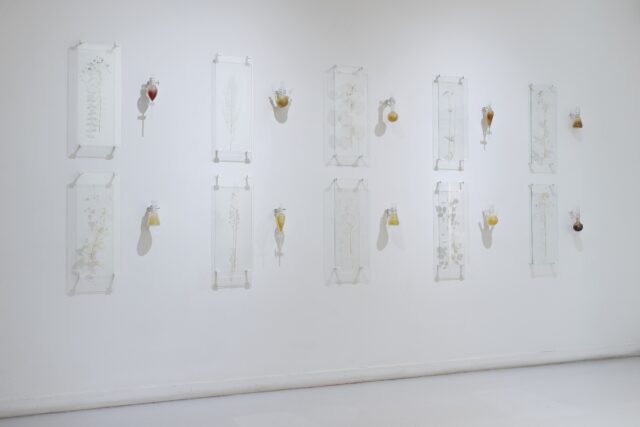
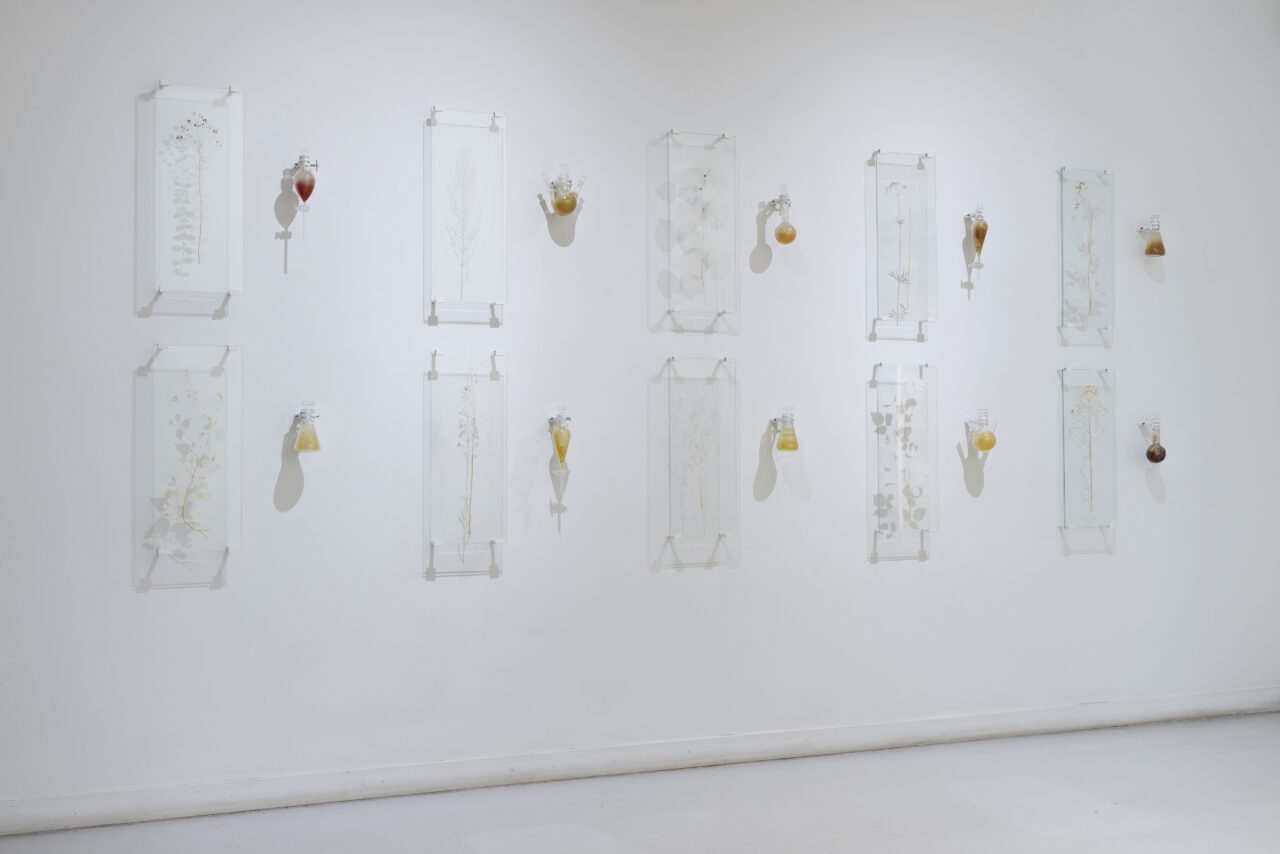
Plants, Healers: Deep SleepElsa Salonen, Plants, Healers: Deep Sleep, sleep-inducing medicinal plants collected from Finland and Germany, colour pigments and medicinal substances distilled from the plants, isomalt, glass, metal, 2023-2024. Photo: LT.
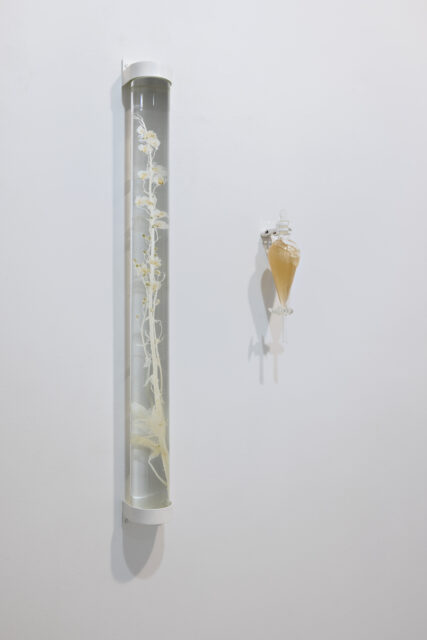
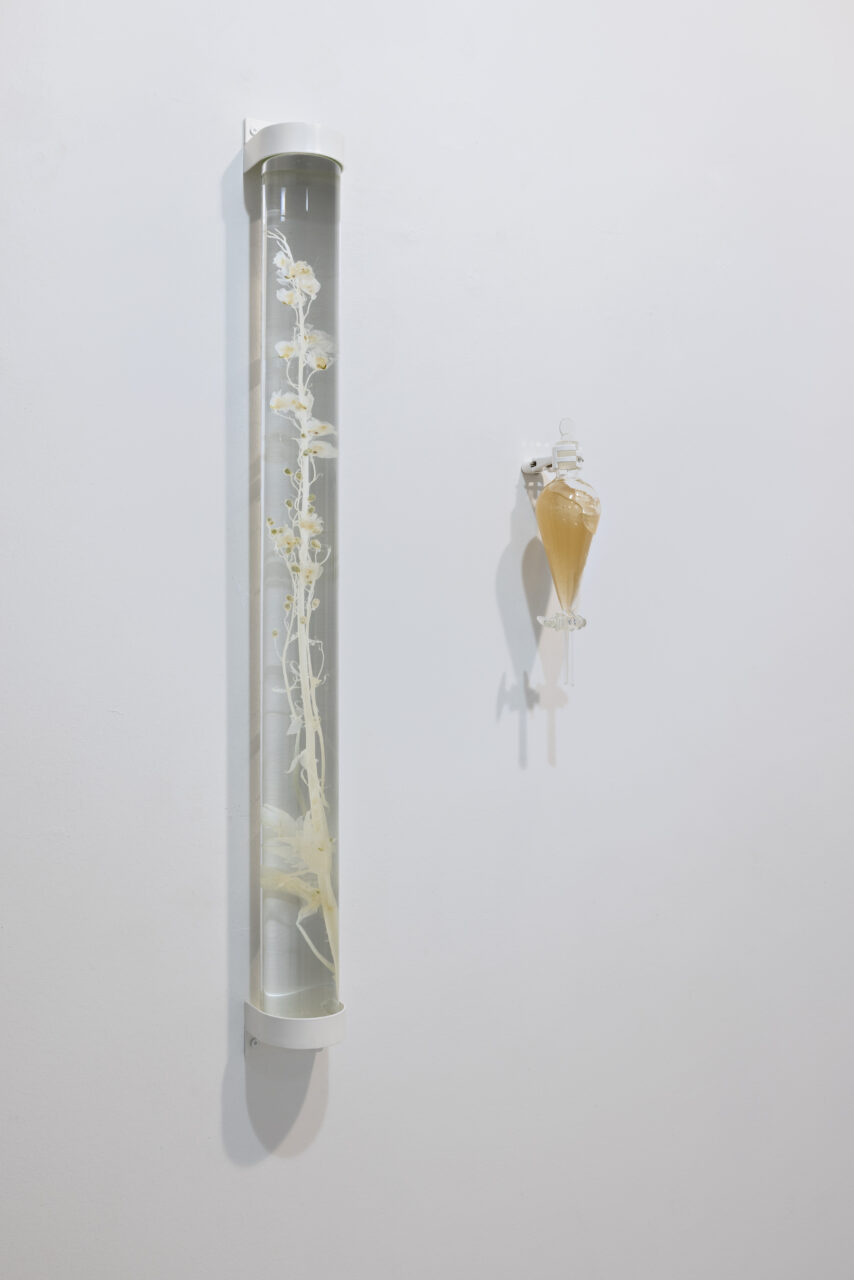
Spirit Collections (Yellow Delphinium)Elsa Salonen, Spirit Collections (Yellow Delphinium), a decoloured alpine delphinium and its distilled colour pigments, preservative fluid, isomalt, glass, metal , 107 cm x 10 cm x 10 cm ,2024. Photo: LT.
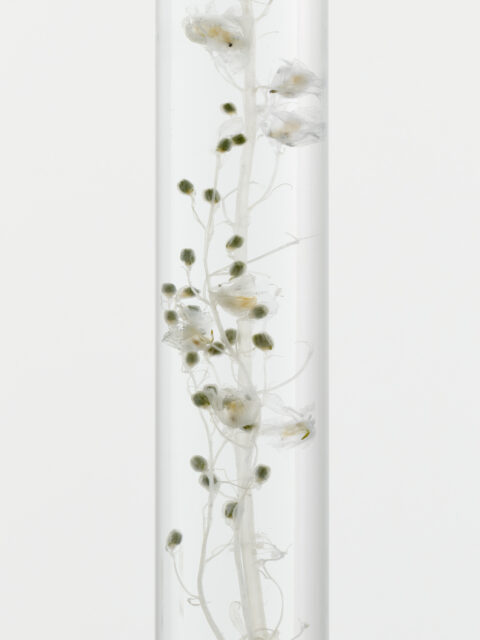
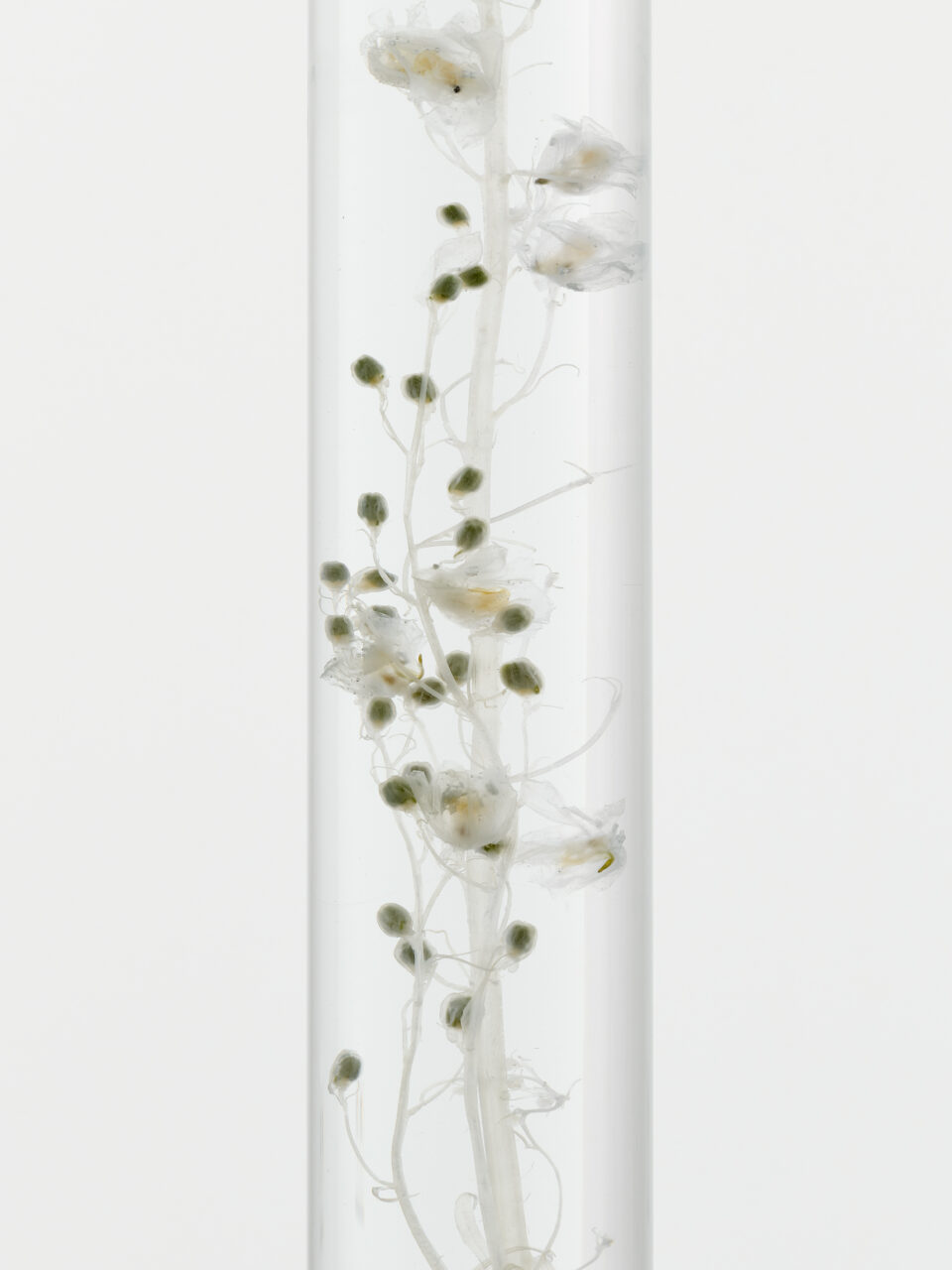
Spirit Collections (Yellow Delphinium)Elsa Salonen, Spirit Collections (Yellow Delphinium), detail, 107 cm x 10 cm x 10 cm ,2024. Photo: Joe Clark.
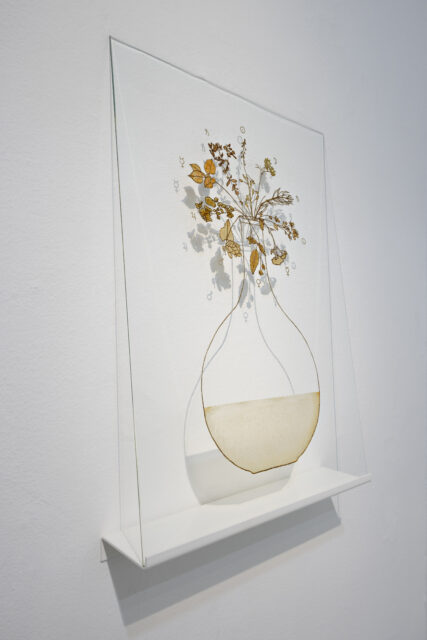
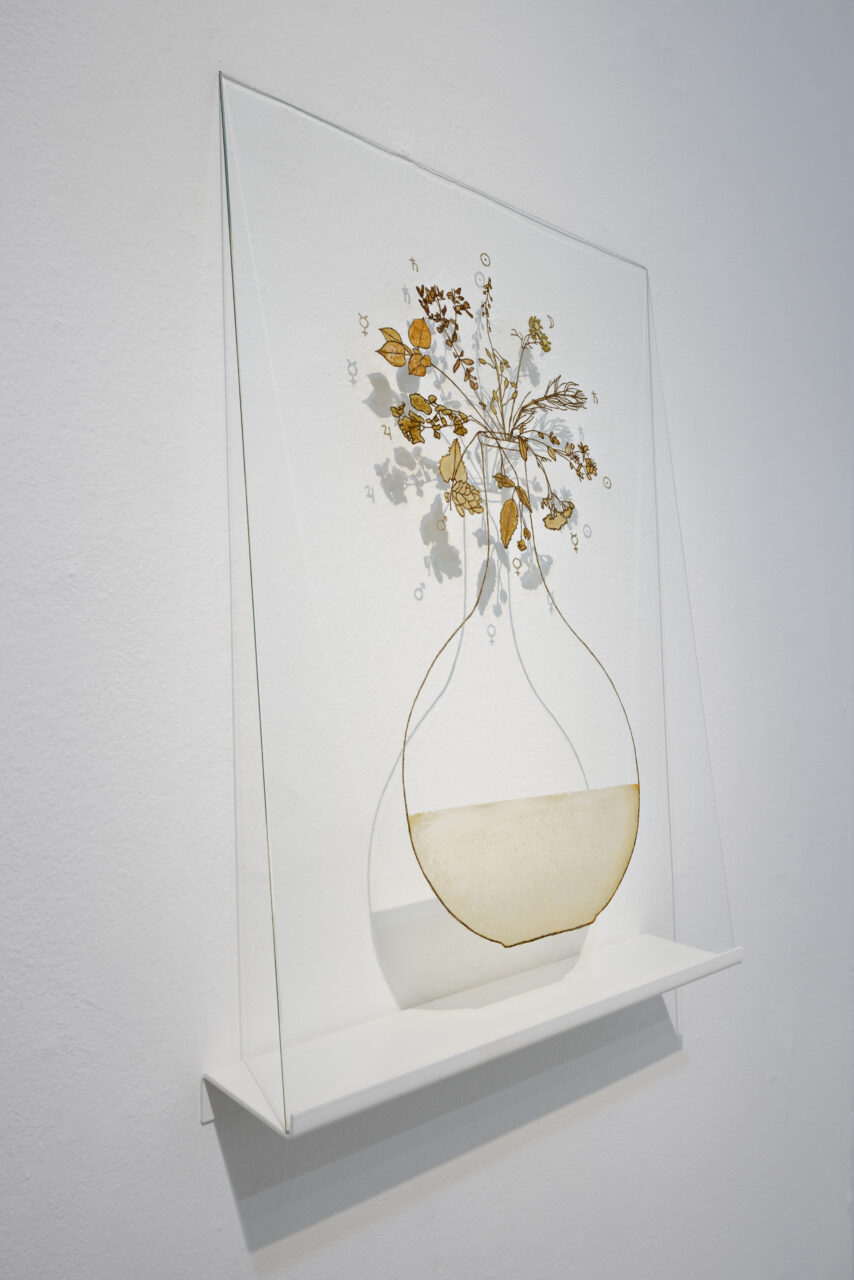
Heavenly Herbs (Spagyric Elixir for Deep Sleep)Elsa Salonen, Heavenly Herbs (Spagyric Elixir for Deep Sleep), stone meteorite dust and colour pigments extracted from sleep-inducing medicinal plants on glass, metal shelf, 60 cm x 42 cm ,2024. Photo: LT.
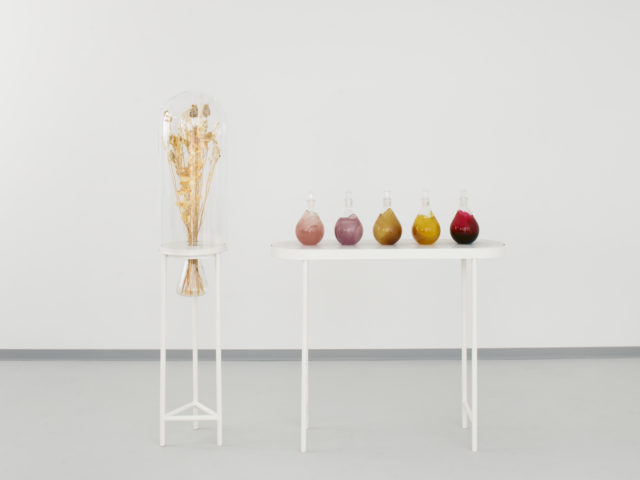
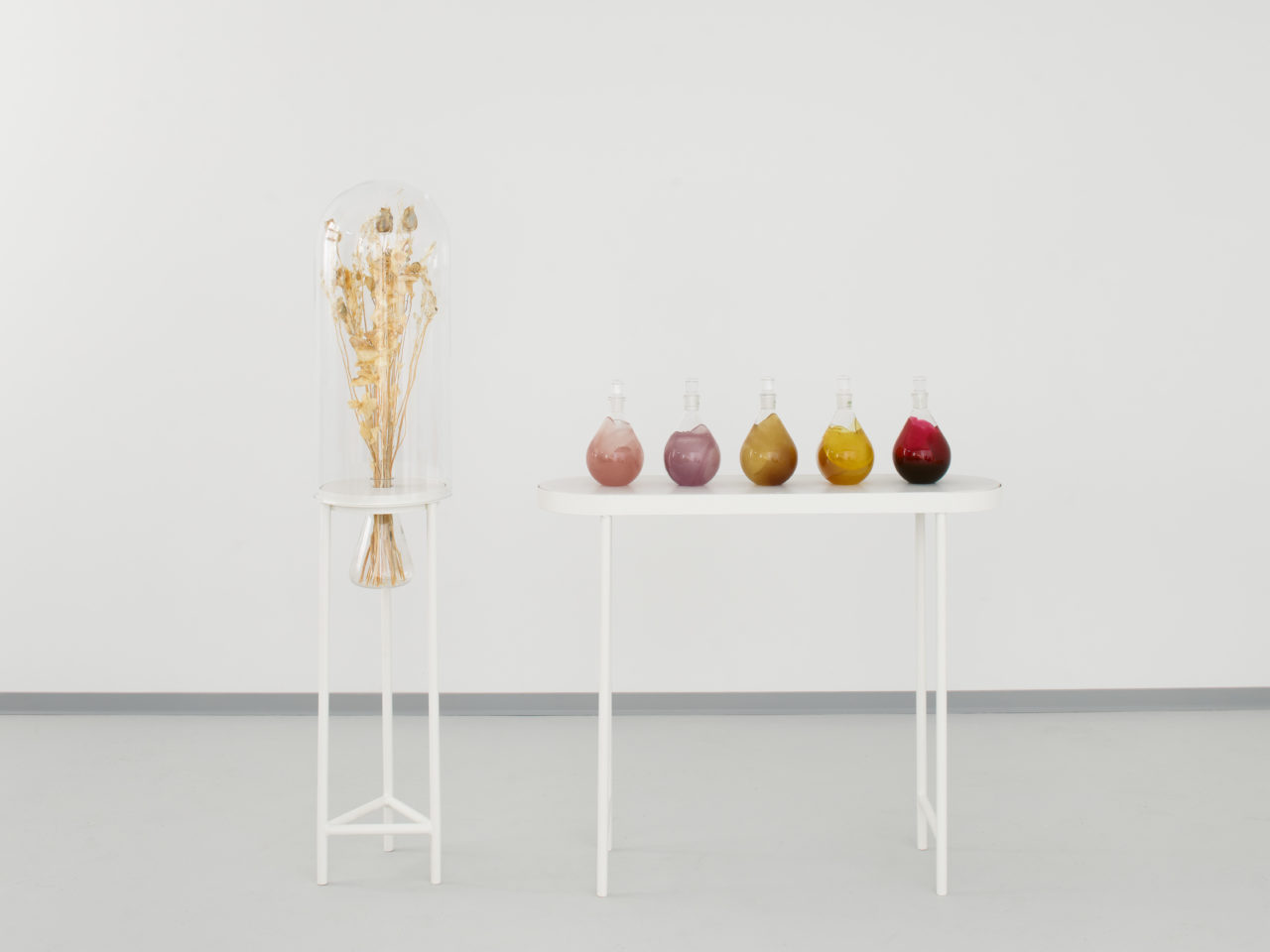
Still Life with Flowers (from Pink to Red)Elsa Salonen, Still Life with Flowers (from Pink to Red), a decoloured flower bouquet and its distilled colour pigments, isomalt, glass, metal, cement (The artist extracted colours from the different flowers of a bouquet (chinese delphiniums, alpine delphiniums, eucalyptus, safflowers, and roses), leaving the plants pale and colourless. The distilled colour pigments were then conserved in transparent isomalt and displayed in glass bottles alongside the white bouquet.), 150 cm x 150 cm x 30 cm ,2022-2023. Photo: Joe Clark.
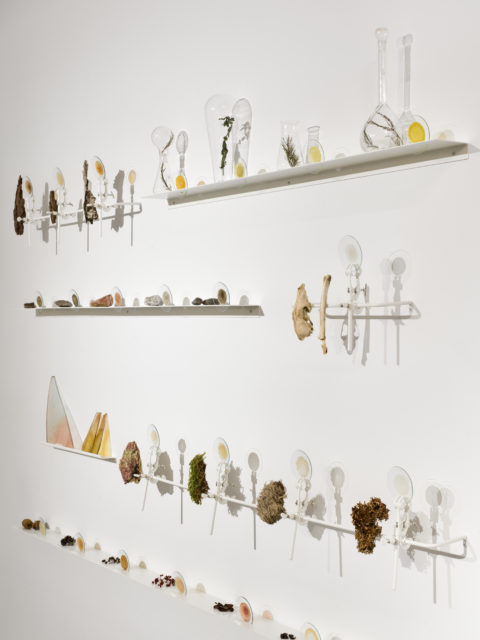

Pyhästä lehdosta vuodatettu väriElsa Salonen, Pyhästä lehdosta vuodatettu väri, stones, animal bones, plants, and mushrooms collected from the Finnish forests, colours distilled or ground from them, glass, metal (From the forests of Southwest Finland, the artist collected stones, animal bones, plants, and mushrooms. From the collected materials Salonen distilled or ground colours with which she then painted the glasses. In Finnish folklore, the forest has been a sacred place for enjoying festive meals and sacrificing to the sprites of the woods. In 1229, Pope Gregory IX of Rome legitimised the sacred forests used for pagan worship as the property of the Church of Finland. Sacred trees were cut down until the 19th century, and many of the oldest churches in Southwest Finland were founded on or near sacred groves - places that were used to being experienced as holy. The title in Finnish, ‘Pyhästä lehdosta vuodatettu väri’, Colour Shed from the Holy Grove, is a wordplay; ‘väri’ meaning colour, and ‘veri’ meaning blood.), 300 cm x 400 cm x 30 cm ,2021-2022. Photo: Joe Clark.
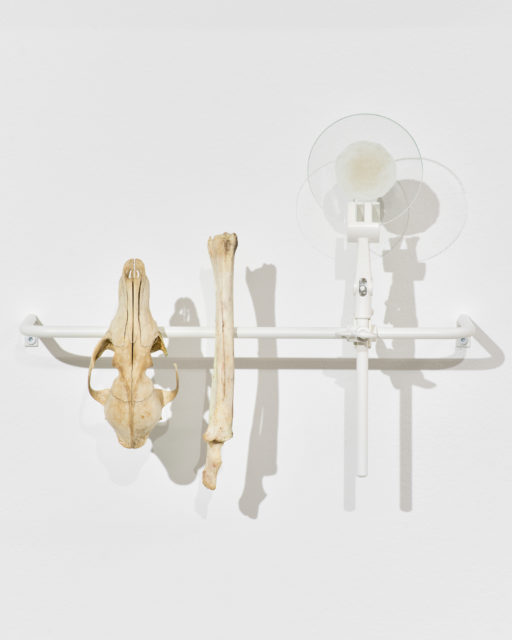
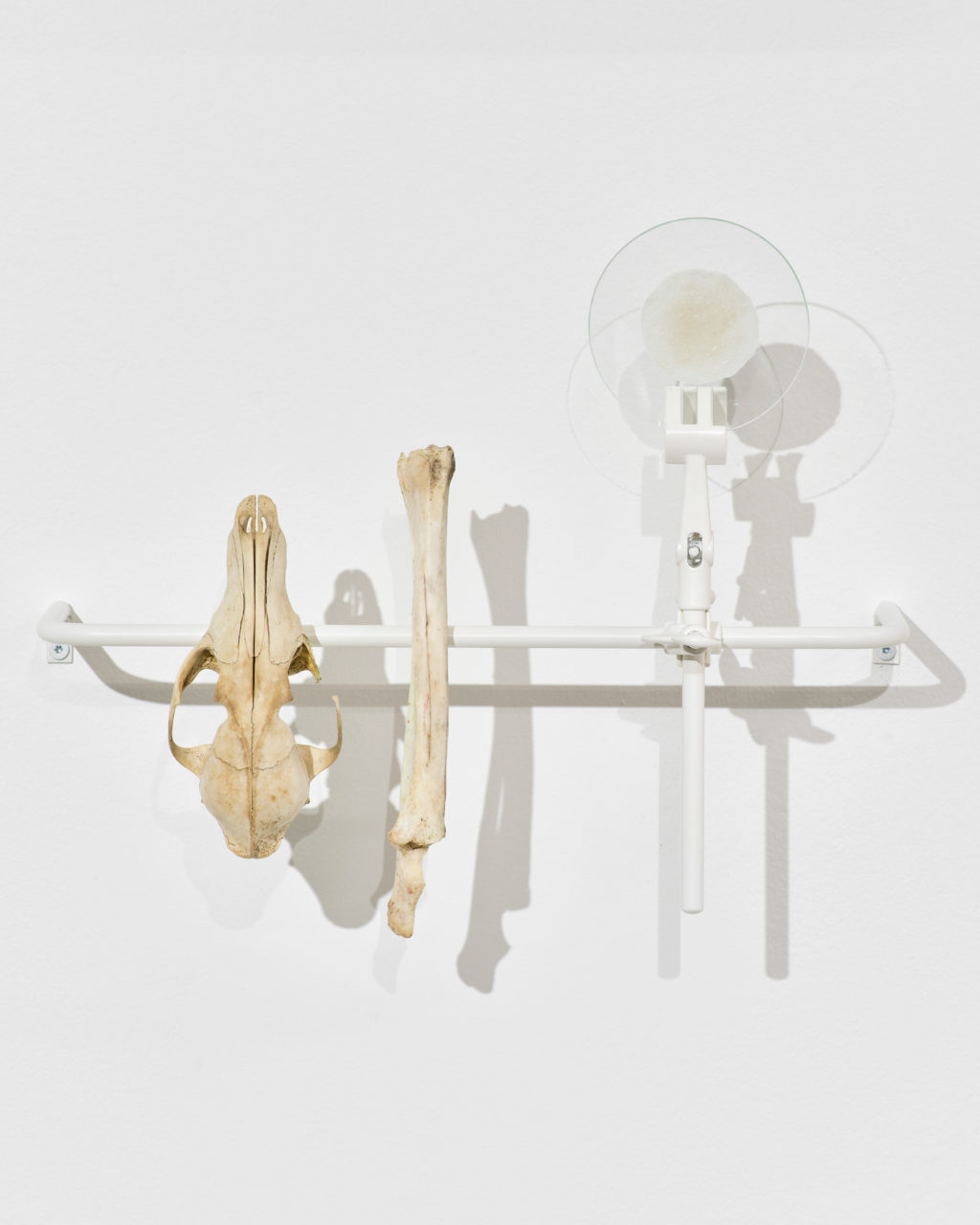
Pyhästä lehdosta vuodatettu väriElsa Salonen, Pyhästä lehdosta vuodatettu väri, detail, 300 cm x 400 cm x 30 cm ,2021-2022. Photo: Joe Clark.
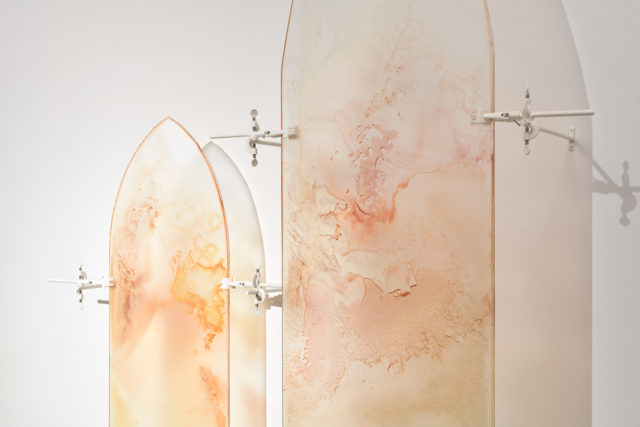

Pyhästä lehdosta vuodatettu väriElsa Salonen, Pyhästä lehdosta vuodatettu väri, stones, animal bones, plants, and mushrooms collected from the Finnish forests, colours distilled or ground from them, glass, metal (From the forests of Southwest Finland, the artist collected stones, animal bones, plants, and mushrooms. From the collected materials Salonen distilled or ground colours with which she then painted the glasses.), 300 cm x 400 cm x 30 cm ,2021-2022. Photo: Joe Clark.
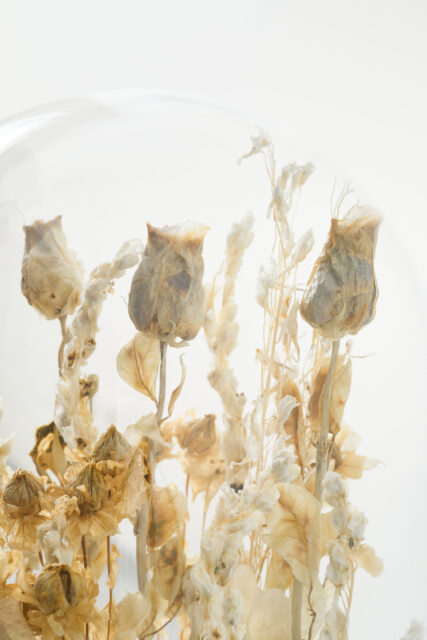
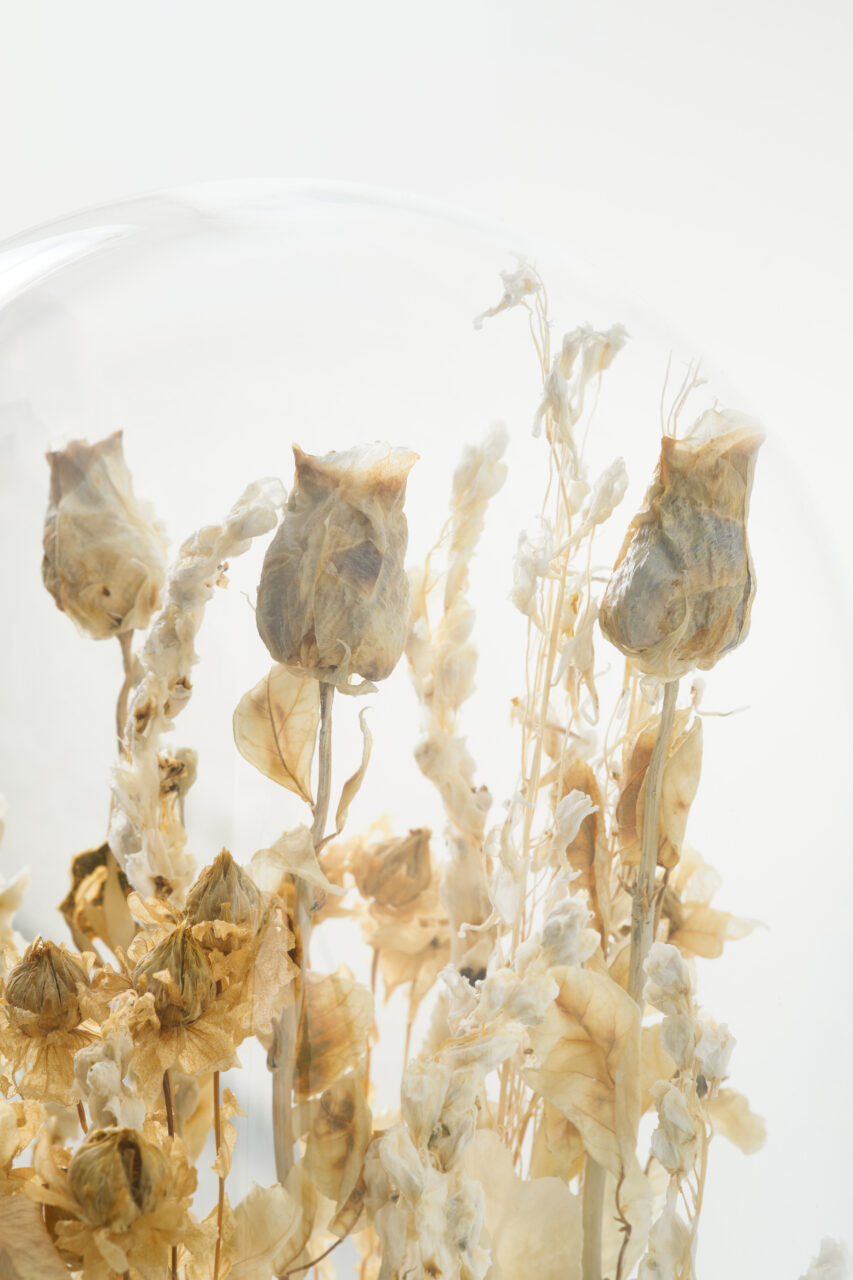
Still Life with Flowers (from Pink to Red), detailElsa Salonen, Still Life with Flowers (from Pink to Red), detail, a decoloured flower bouquet and its distilled colour pigments, isomalt, glass, metal, cement (The artist extracted colours from the different flowers of a bouquet (chinese delphiniums, alpine delphiniums, eucalyptus, safflowers, and roses), leaving the plants pale and colourless. The distilled colour pigments were then conserved in transparent isomalt and displayed in glass bottles alongside the white bouquet.), 150 cm x 150 cm x 30 cm ,2022-2023. Photo: Joe Clark.
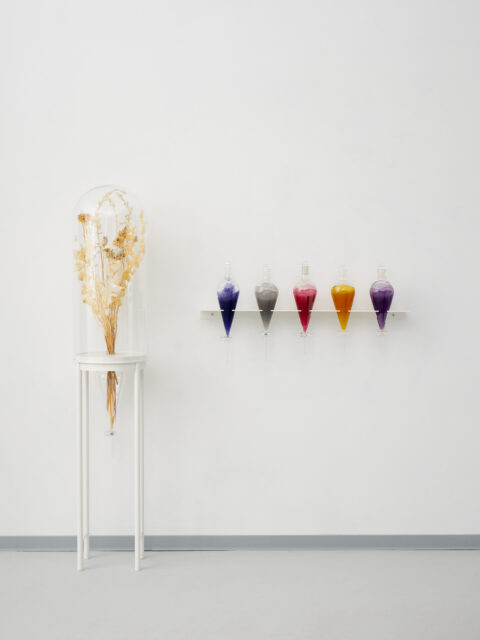
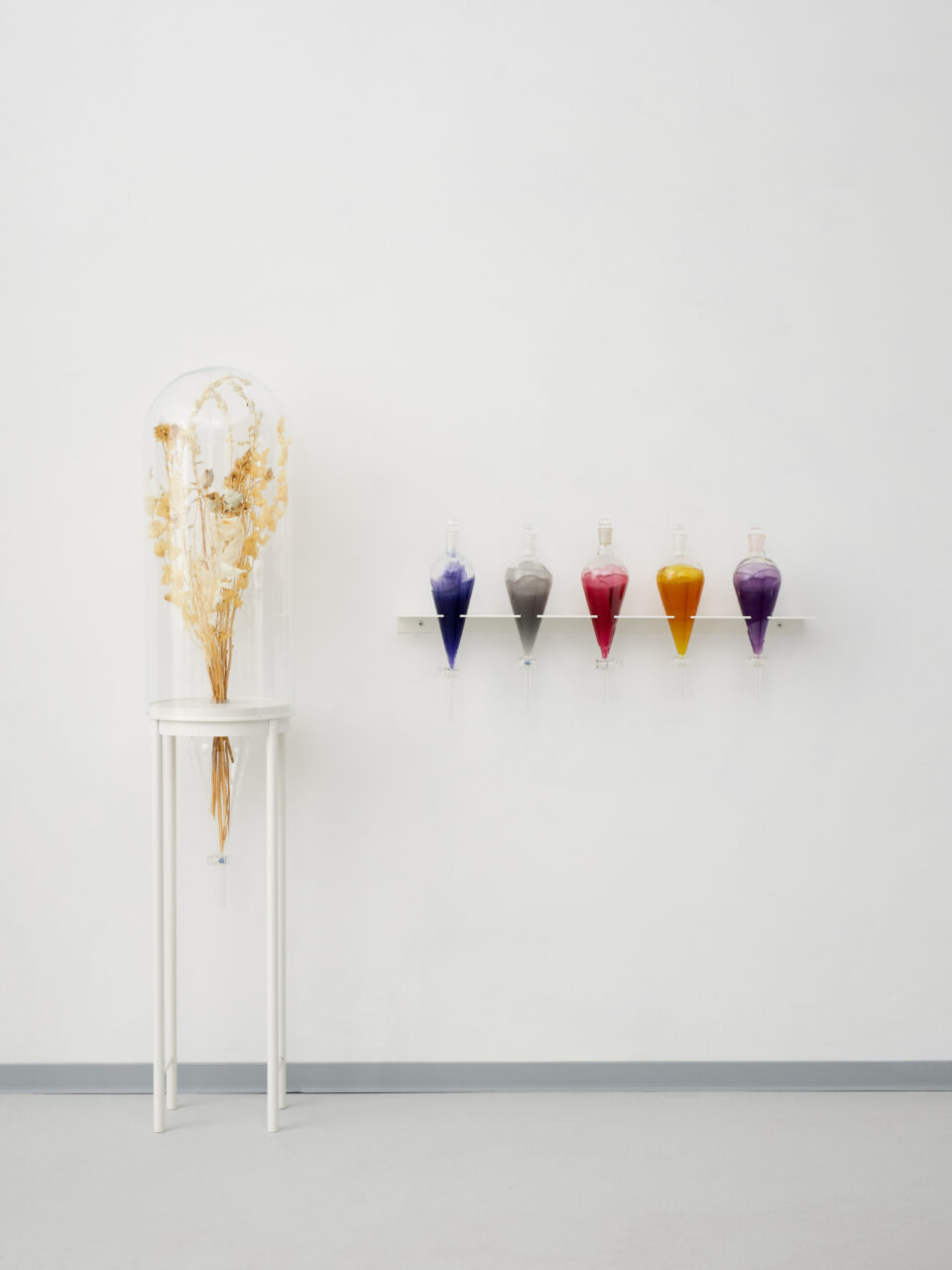
Still Life with Flowers (Separation Funnels)Elsa Salonen, Still Life with Flowers (Separation Funnels), a decoloured flower bouquet and its distilled colour pigments, isomalt, glass, metal, cement (The artist extracted colours from the different flowers of a bouquet (chinese delphiniums, alpine delphiniums, eucalyptus, safflowers, and roses), leaving the plants pale and colourless. The distilled colour pigments were then conserved in transparent isomalt and displayed in glass bottles alongside the white bouquet.), 150 cm x 140 cm x 30 cm ,2023. Photo: Joe Clark.
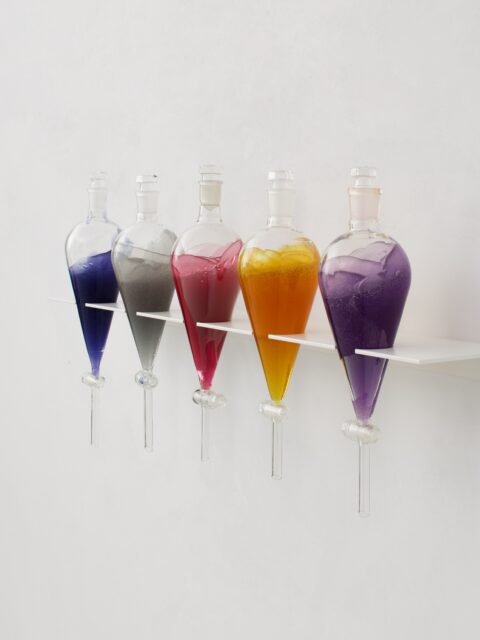
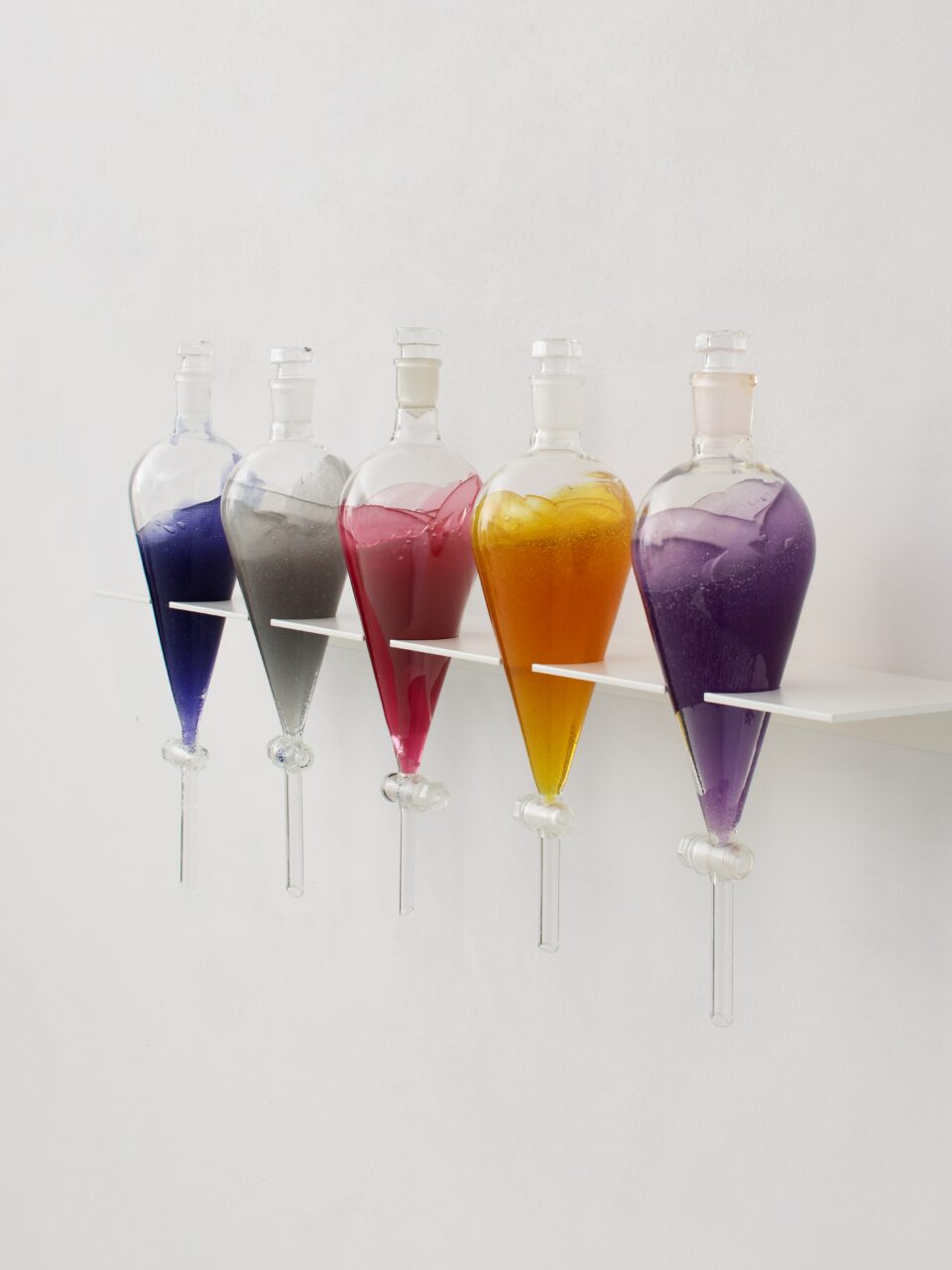
Still Life with Flowers (Separation Funnels), detailElsa Salonen, Still Life with Flowers (Separation Funnels), detail, a decoloured flower bouquet and its distilled colour pigments, isomalt, glass, metal, cement (The artist extracted colours from the different flowers of a bouquet (chinese delphiniums, alpine delphiniums, eucalyptus, safflowers, and roses), leaving the plants pale and colourless. The distilled colour pigments were then conserved in transparent isomalt and displayed in glass bottles alongside the white bouquet.), 150 cm x 140 cm x 30 cm ,2023. Photo: Joe Clark.
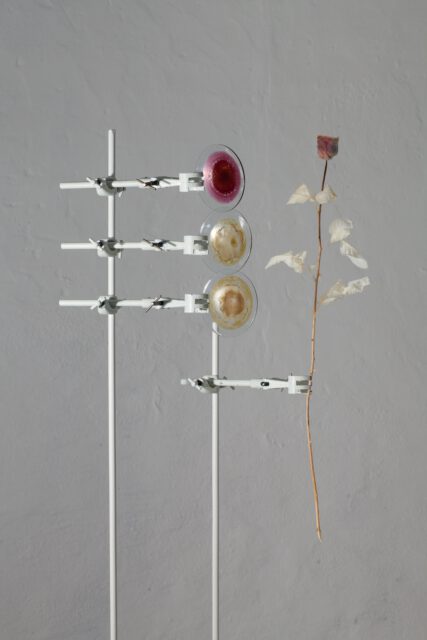
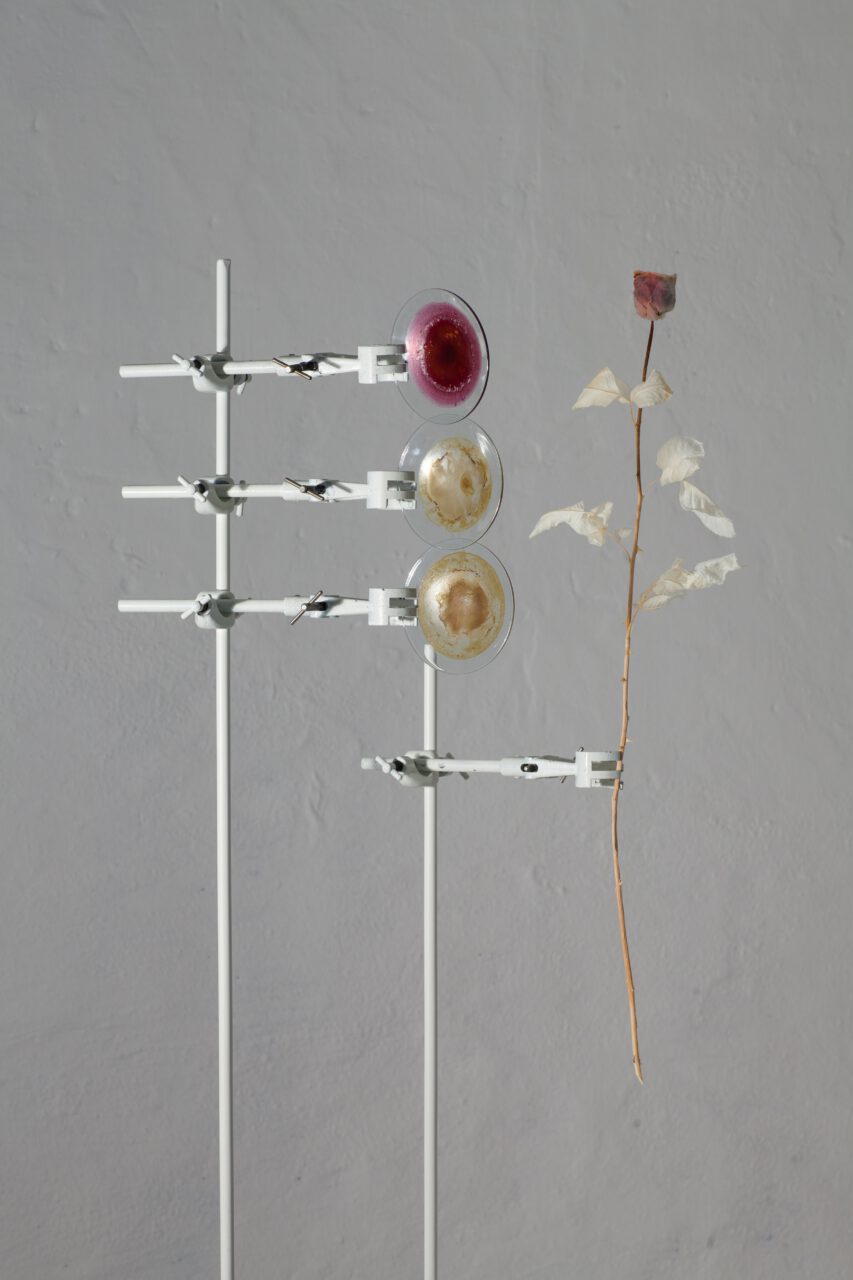
Elsa Salonen, Study of Eternal CycleElsa Salonen, Elsa Salonen, Study of Eternal Cycle, a decoloured rose and its distilled colour pigments, glass, metal, light (The artist distilled colours from the petals and leaves of a red rose, leaving the plant pale and colourless. Using the strong red pigments of the petals and the weaker, yellowish pigments of the leaves, the artist painted three rounded laboratory glasses. In the exhibition space, a spotlight illuminates the painted glasses, reflecting the colours back to the white rose, making it once more appear vivid and red.), Dimensions variable cm ,2014. Photo: Jere Salonen.
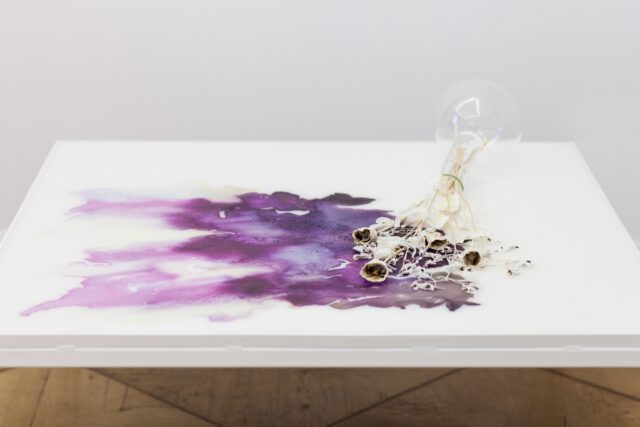
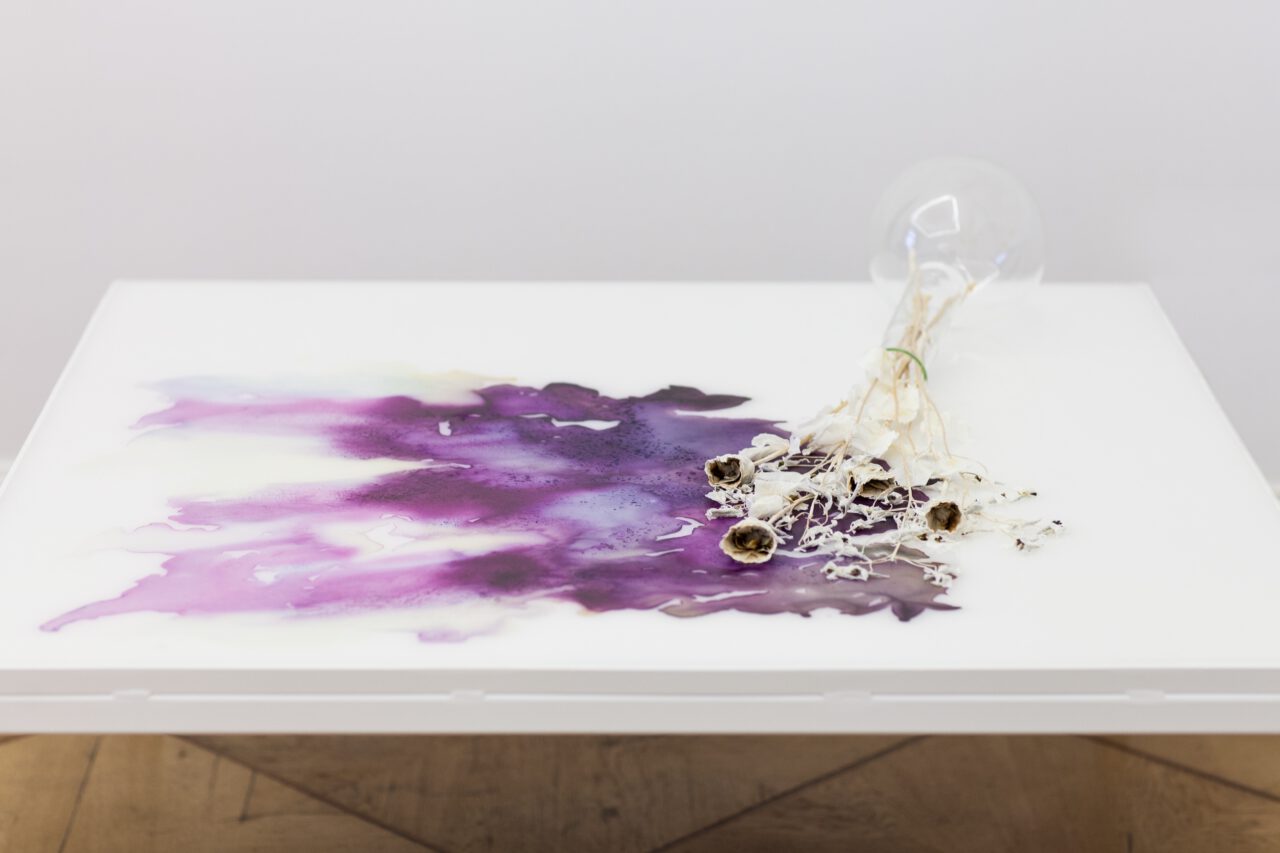
Elsa Salonen, Everything Vanishes, Except Life ItselfElsa Salonen, Elsa Salonen, Everything Vanishes, Except Life Itself, decoloured roses and delphiniums, their distilled colour pigments, acrylic glass, glass (The artist distilled colours from red roses and blue delphiniums, leaving the plants pale and colourless. Using only these extracted colours, she painted a splash of colour on a table. The white flower bouquet is shown in a glass vessel next to the painting.), 60 cm x 100 cm x 100 cm ,2014. Photo: Jere Salonen.
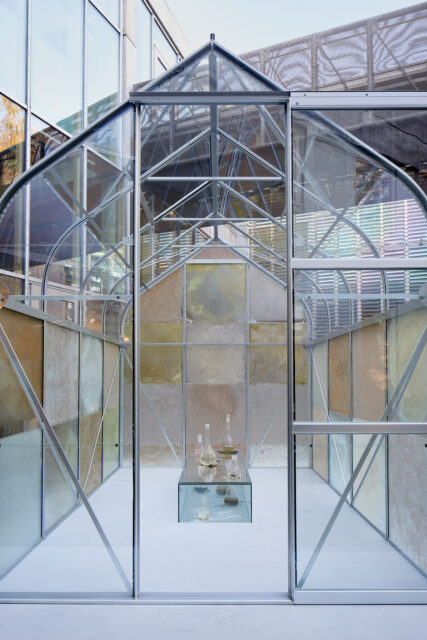
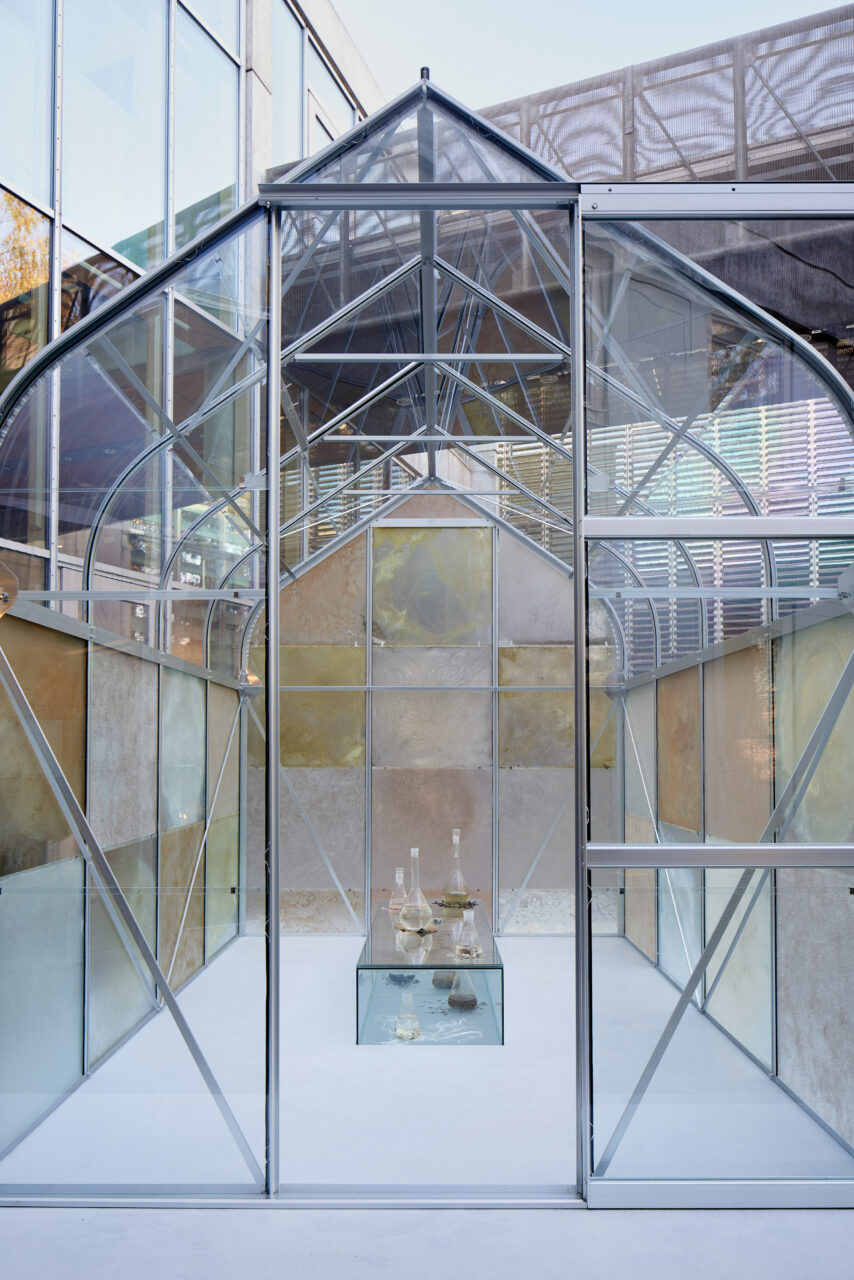
Veden väelleElsa Salonen, Veden väelle, natural elements collected from the Finnish Baltic Sea and its shores, colours distilled or ground from them, glasshouse, glass, silver, lights (For the installation, various natural elements were collected from the Finnish Baltic Sea and its shores; such as algae, aquatic plants, seawater, seabed sand and pieces of cliffs as well as shells and fish bones which had drifted onto the beach. From the collected materials the artist distilled or ground colours with which she then painted the walls of a glasshouse. The remaining algae were dried, powdered and used to create the symmetric pattern in the middle of the installation. ‘Veden väelle’ (For the Water Sprites) is dedicated to the ancient sea sprites. According to Finnish mythology, each natural environment is governed by its own sprite, who guards the region affecting its well-being and prosperity. To ensure good fishing fortune various offerings, such as silver, were brought to the mighty Water Sprites.), 350 cm x 260 cm x 260 cm ,2019. Photo: Joe Clark.
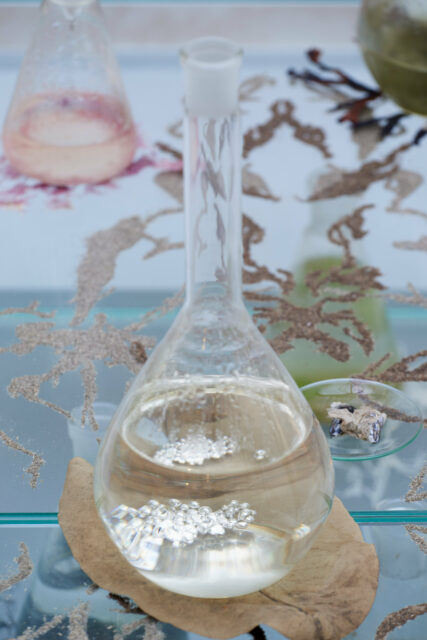
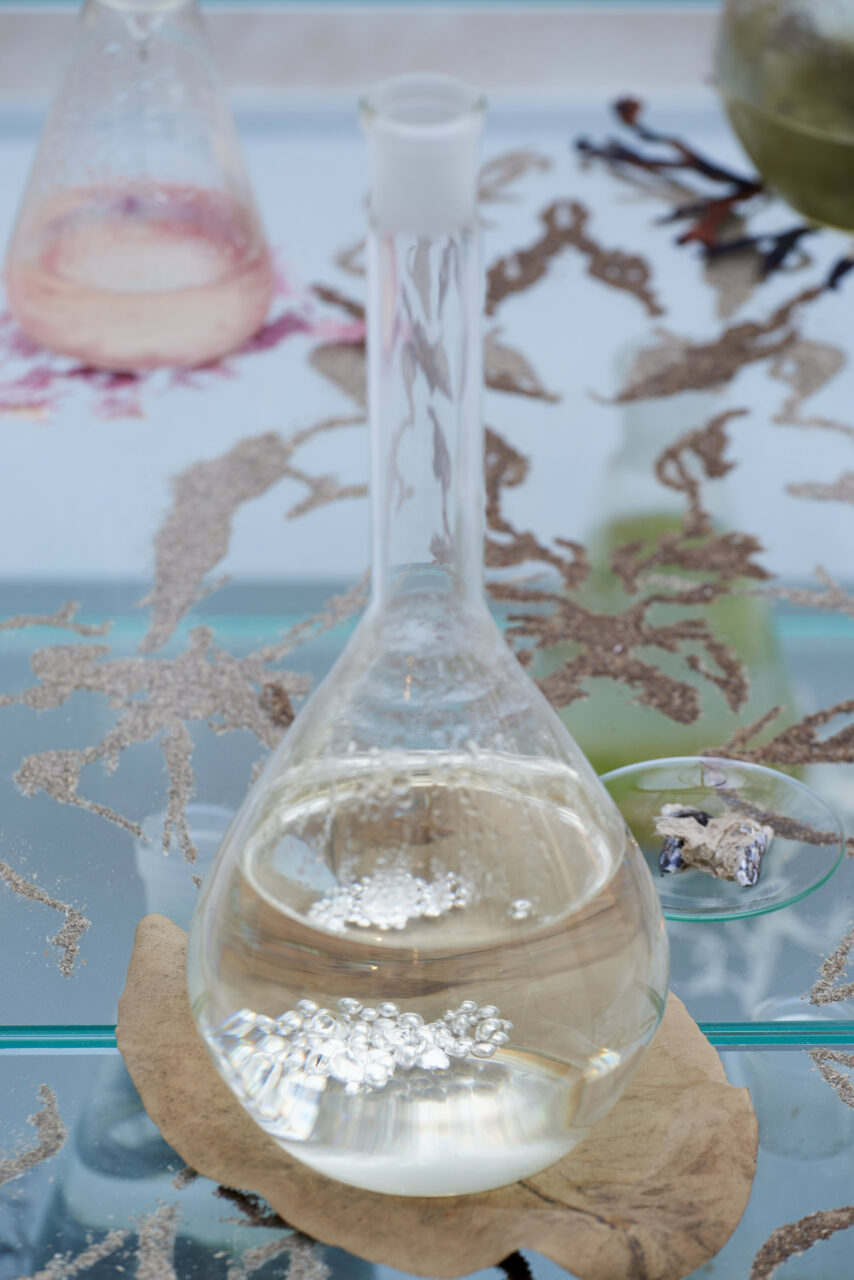
Veden väelle, detailElsa Salonen, Veden väelle, detail, natural elements collected from the Finnish Baltic Sea and its shores, colours distilled or ground from them, glasshouse, glass, silver, lights, 350 cm x 260 cm x 260 cm ,2019. Photo: Joe Clark.
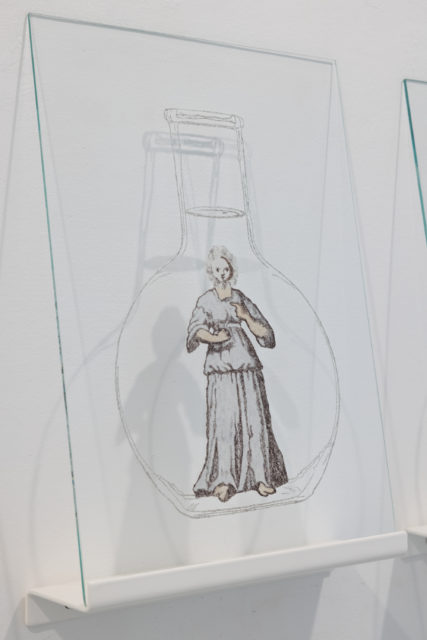
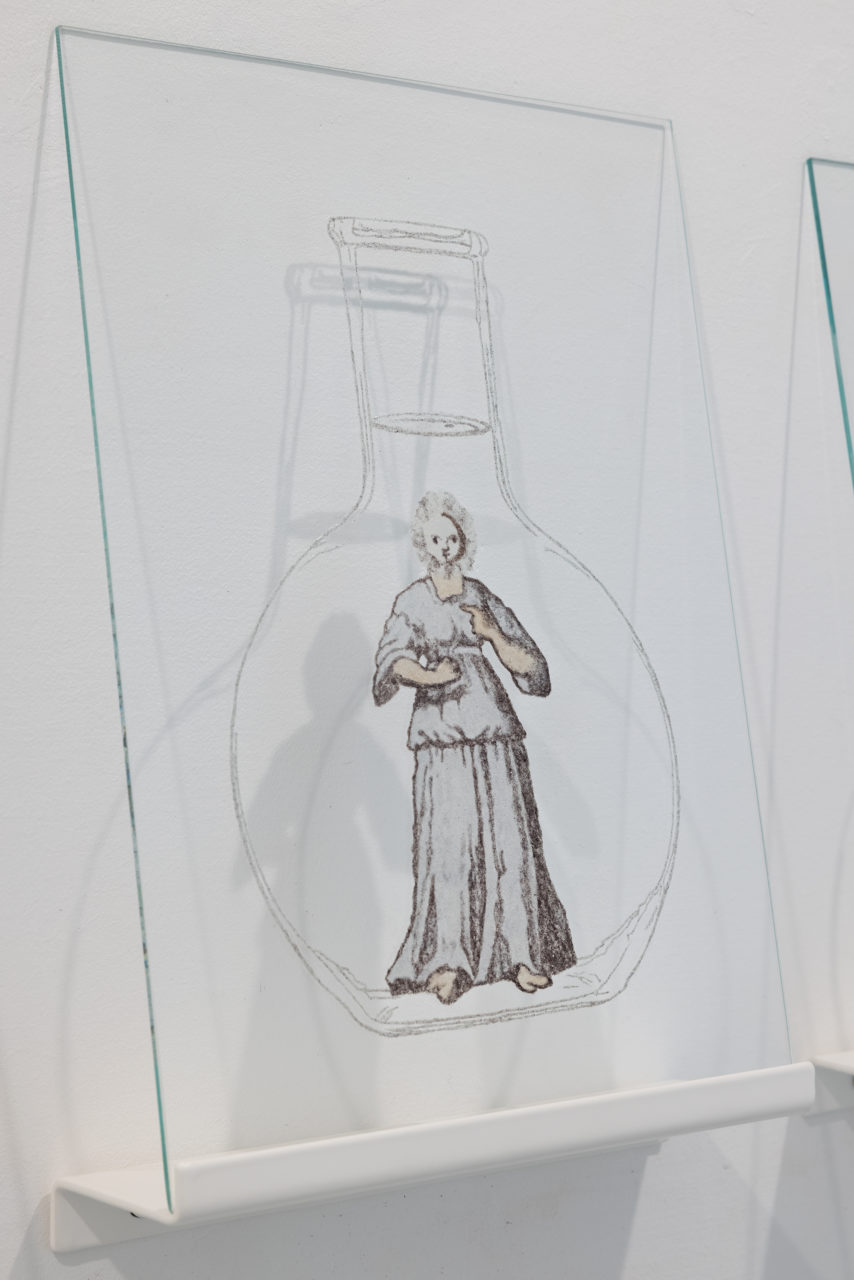
Influence of the Moon on Bodies of WaterElsa Salonen, Influence of the Moon on Bodies of Water, seashells, coral skeletons, and limestone collected from various shores on glass, metal shelves (works painted at different stages of the lunar cycle), a series of eight painting 35 cm x 25 cm x 5 cm ,2020. Photo: LT.
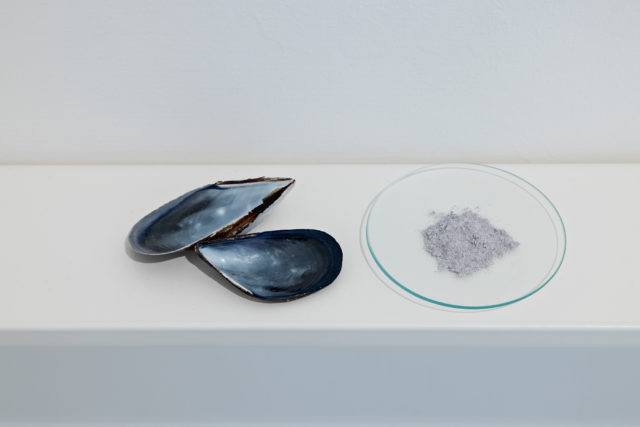
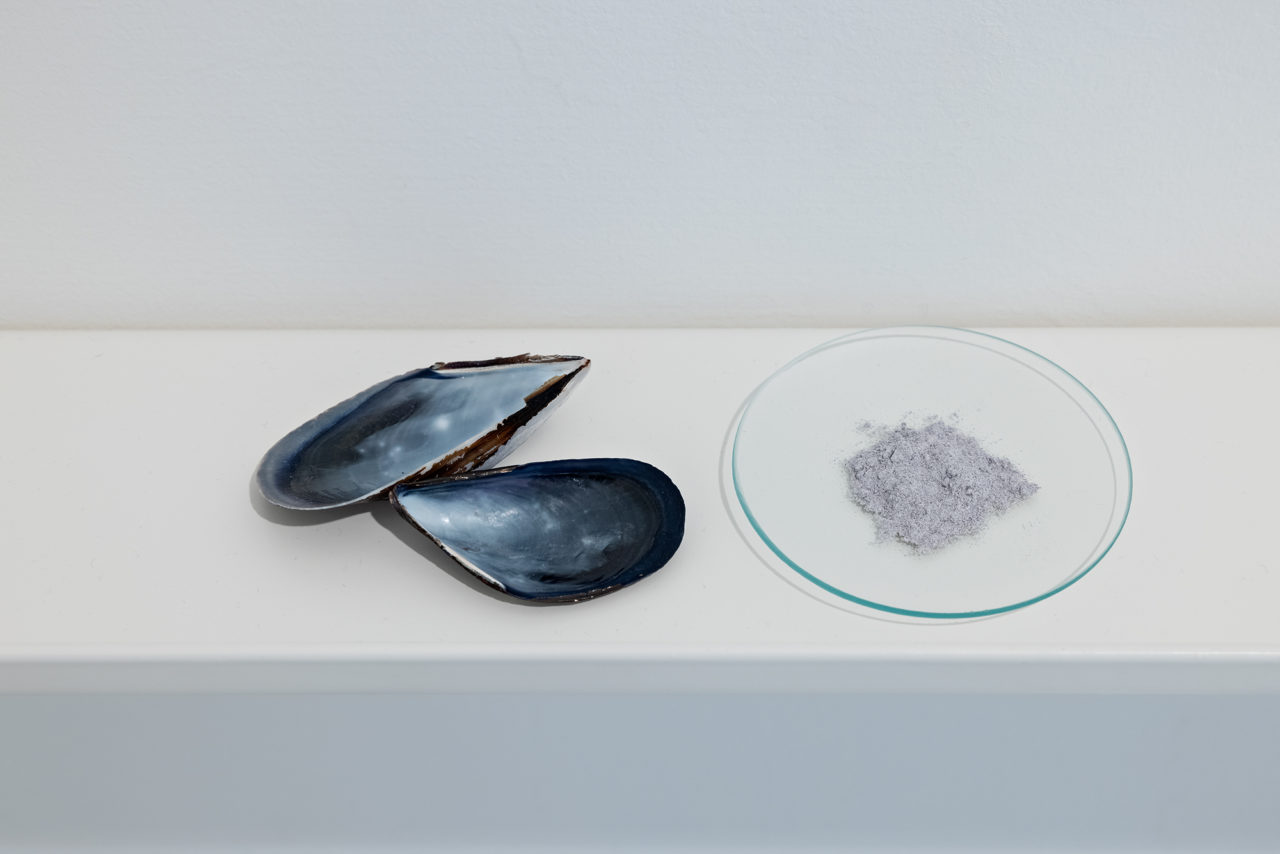
Influence of the Moon on Bodies of WaterElsa Salonen, Influence of the Moon on Bodies of Water, seashells, coral skeletons, and limestone collected from various shores on glass, metal shelves (works painted at different stages of the lunar cycle). (Limestone, seashells, and pieces of dead corals drifted ashore at the northern and southern seas were collected at different times of the tide. From the collected materials the artist ground pigments with which she painted an adaptation of old alchemical illustrations on glass; a female figure with a lunar head inside of a flask. Each work in the series is painted at a different stage of the lunar cycle; a painting depicting the full moon at the time of the full moon, a painting depicting the new moon at the time of the new moon, etc. The moon controls the movements of the tides, and in Finnish folklore, it also defined the lives of the people. The different stages of the lunar cycle influenced the choice of a favourable time to do different jobs. Also in alchemy, the correct position of the celestial bodies was essential for the success of the working phase.), 35 cm x 25 cm x 5 cm ,2020. Photo: LT.
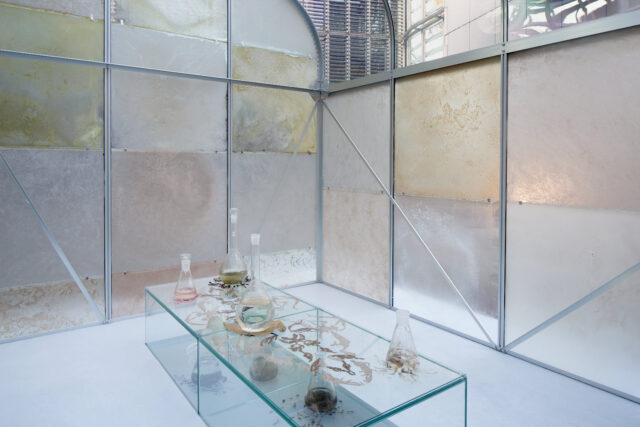
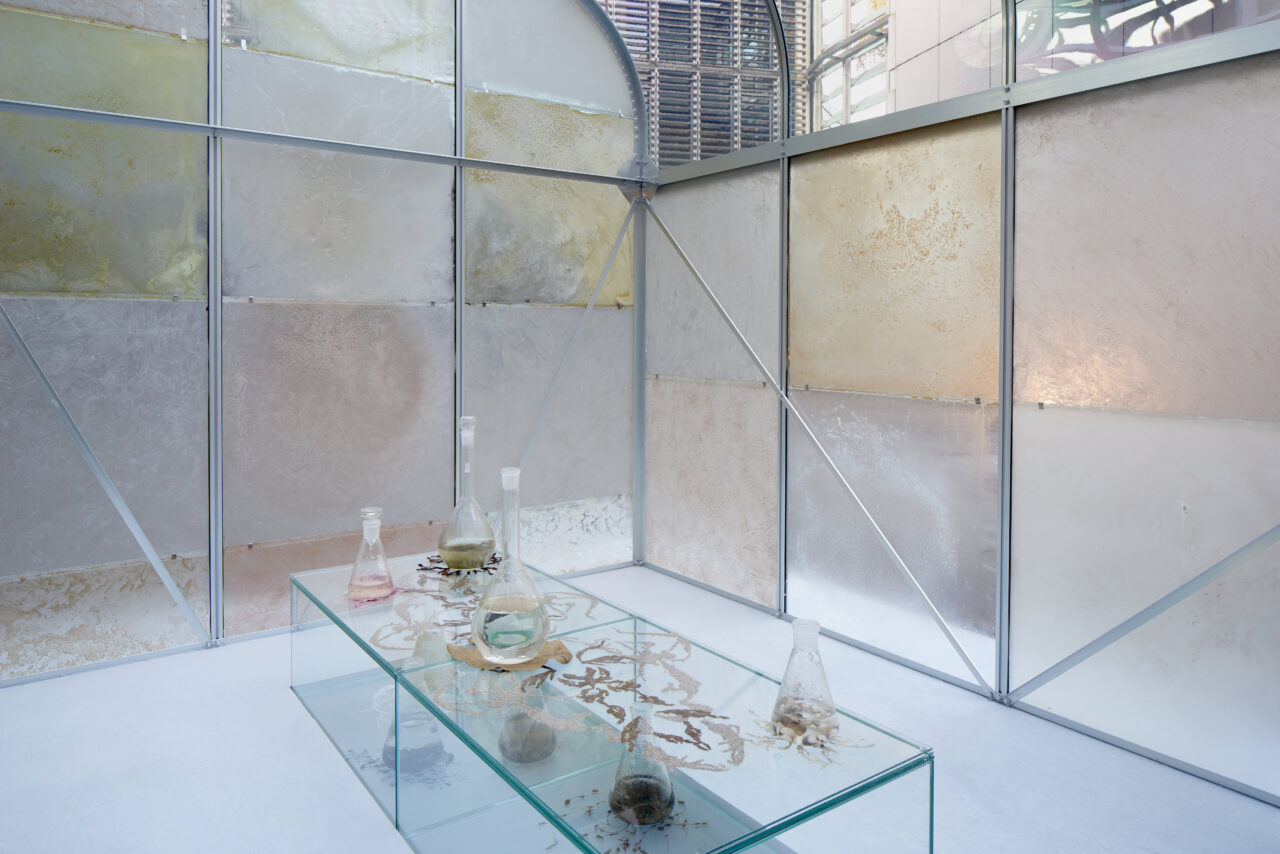
Veden VäelleElsa Salonen, Veden Väelle, natural elements collected from the Finnish Baltic Sea and its shores, colours distilled or ground from them, glasshouse, glass, silver, lights (For the installation, various natural elements were collected from the Finnish Baltic Sea and its shores; such as algae, aquatic plants, seawater, seabed sand and pieces of cliffs as well as shells and fish bones which had drifted onto the beach. From the collected materials the artist distilled or ground colours with which she then painted the walls of a glasshouse. The remaining algae were dried, powdered and used to create the symmetric pattern in the middle of the installation. ‘Veden väelle’ (For the Water Sprites) is dedicated to the ancient sea sprites. According to Finnish mythology, each natural environment is governed by its own sprite, who guards the region affecting its well-being and prosperity. To ensure good fishing fortune various offerings, such as silver, were brought to the mighty Water Sprites.), 350 cm x 260 cm x 260 cm ,2019. Photo: Joe Clark.
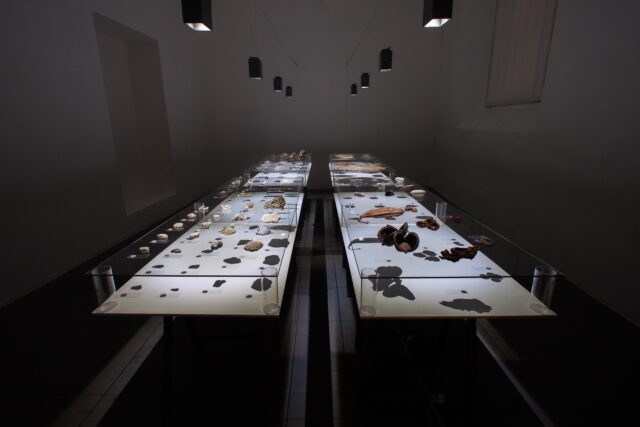
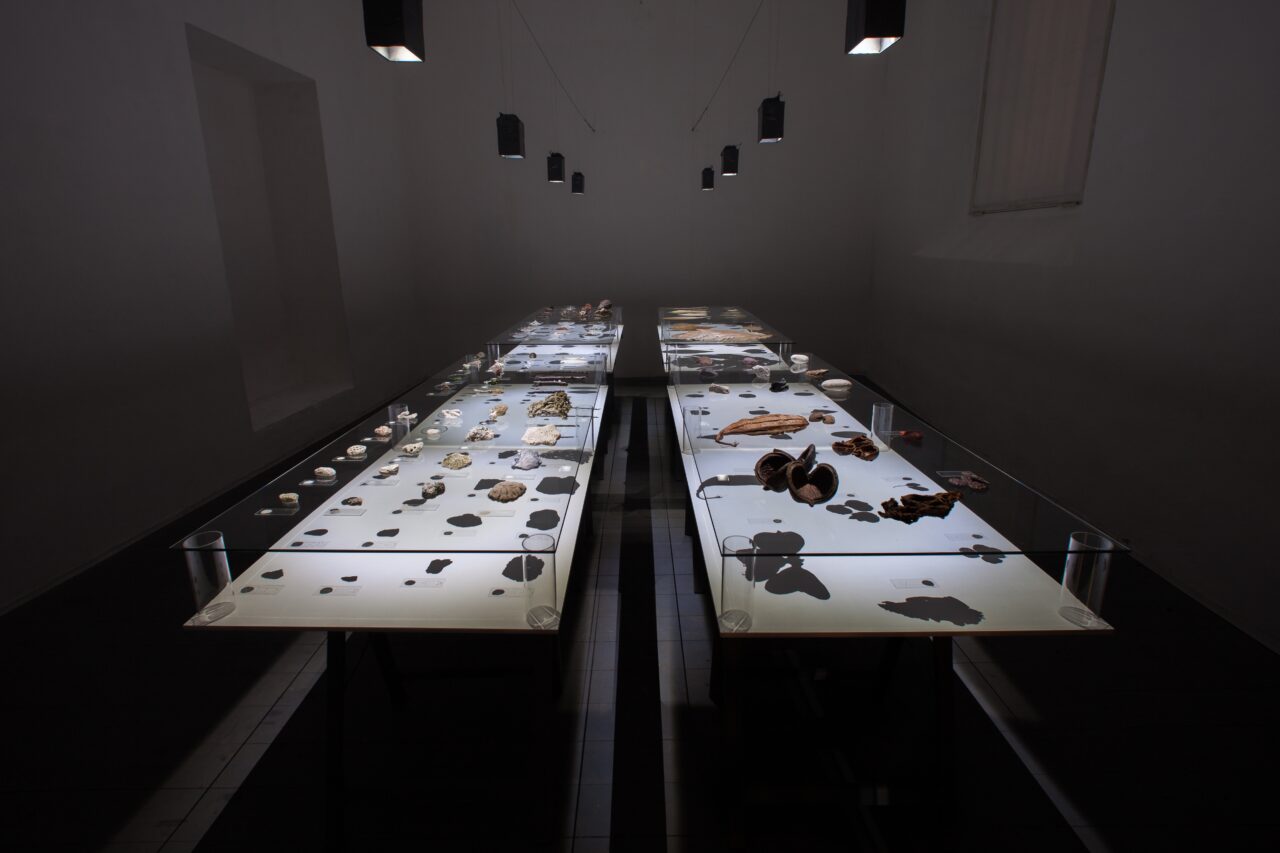
Buni Buana (Hidden World)Elsa Salonen, Buni Buana (Hidden World), natural elements collected from Indonesia and colours distilled or ground from them, glass, transparent acrylic paint, LED lights, 100 cm x 180 cm x 480 cm ,2014-2015. Photo: Jere Salonen.
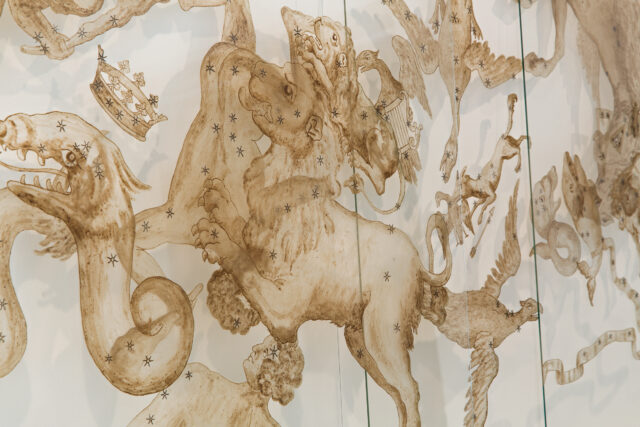
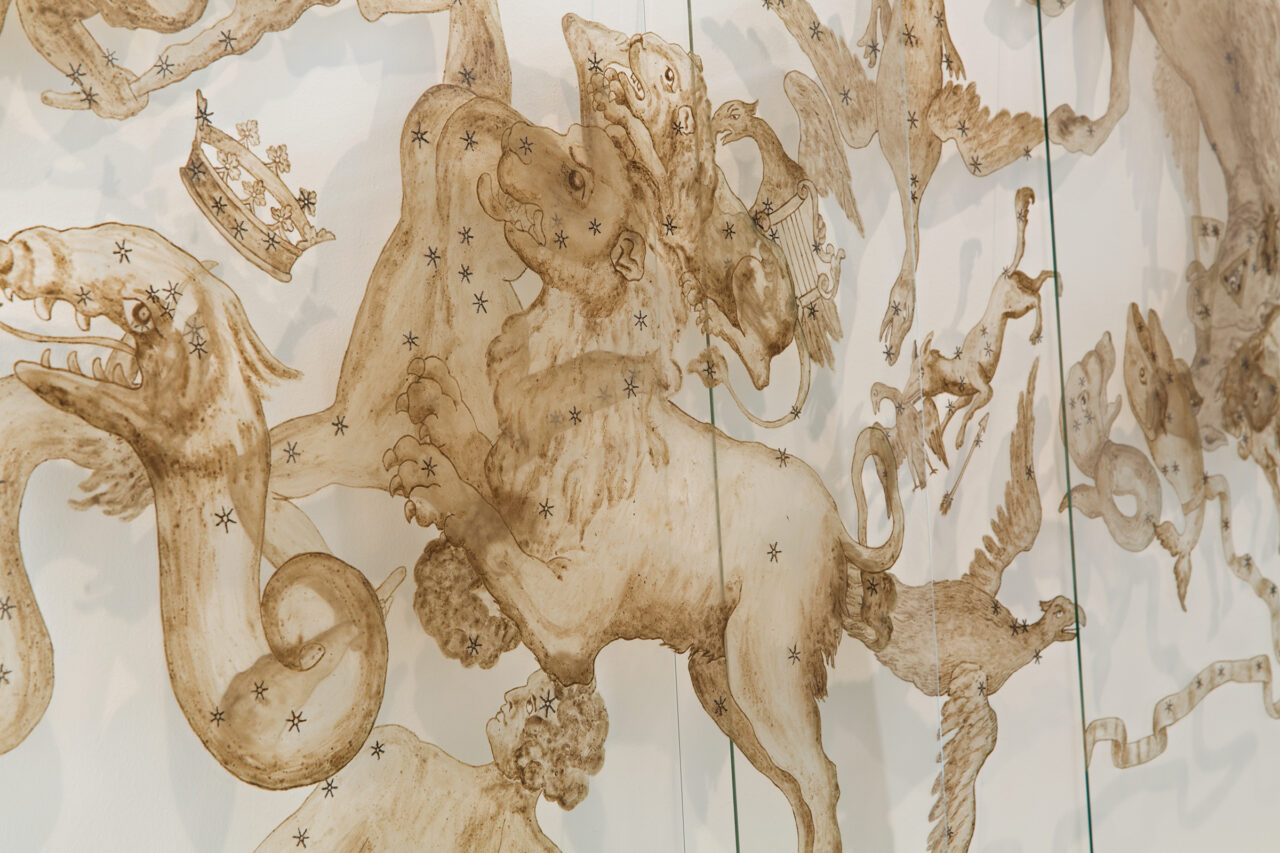
Elsa Salonen, We Are All Made of Stardust (Northern Hemisphere), detailstone and iron meteorite dust on glass (Stone and iron meteorites were finely crushed into dusts. From stone meteorites, achondrites and chondrites, an ocher brownish dust was crushed, whereas from iron meteorites, pallasites and mesosiderites, a dark gray dust was crushed. With the meteorite dusts the artist painted various animal, plant, and human figures from 17th-century star atlas illustrations of constellations on glass), 2017, 100x245 cm
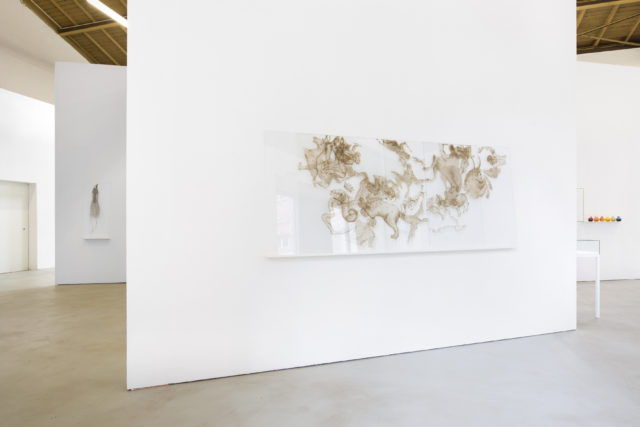
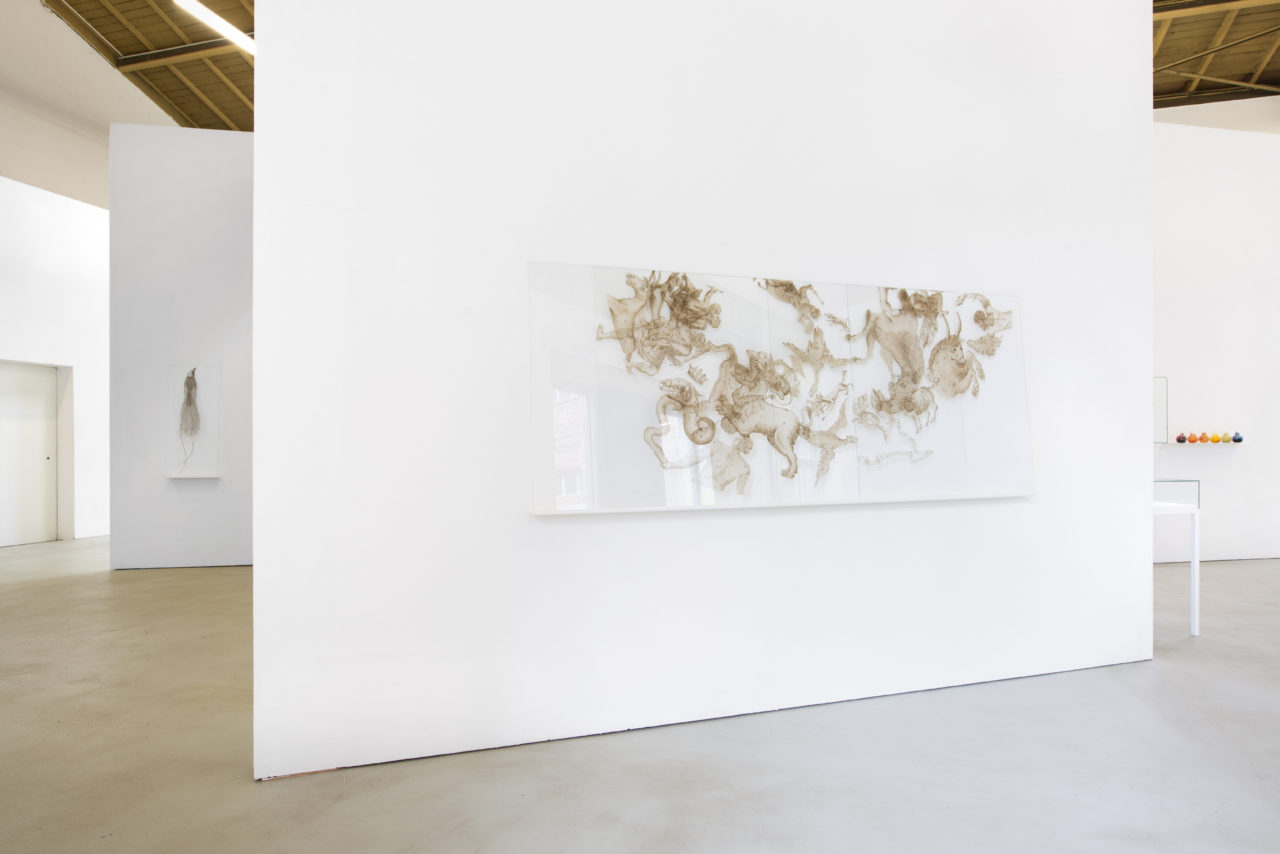
We Are All Made of Stardust (Northern Hemisphere)Elsa Salonen, We Are All Made of Stardust (Northern Hemisphere), stone and iron meteorite dust on glass (Stone and iron meteorites were finely crushed into dusts. From stone meteorites, achondrites and chondrites, an ocher brownish dust was crushed, whereas from iron meteorites, pallasites and mesosiderites, a dark gray dust was crushed. With the meteorite dusts the artist painted various animal, plant, and human figures from 17th-century star atlas illustrations of constellations on glass), 100 cm x 245 cm ,2017. Photo: Björn Siebert.
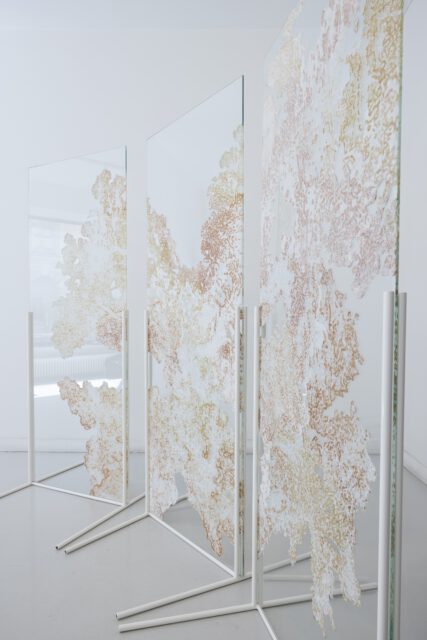
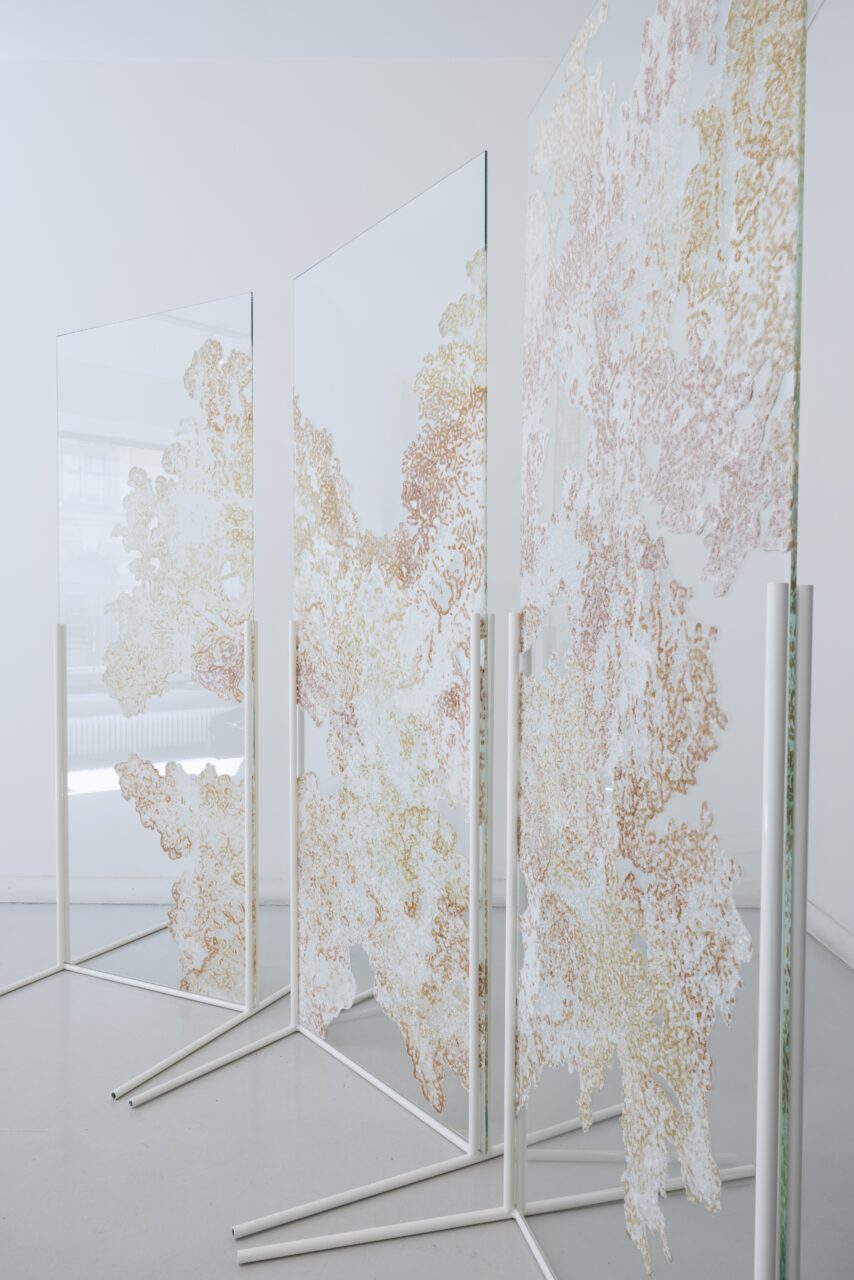
Elsa Salonen, I Dive in the Ocean as in a Prayerochres, plastic debris and sea salt collected from the shores of the Caribbean Sea - Colombia, alum crystal on glass (From the Colombian beaches of the Caribbean Sea, the artist collected ochres and plastic debris drifted ashore. These materials she ground into pigments that were used, together with sea salt and alum, to paint an underwater landscape of a bleaching coral reef on glass), 2021, dimensions variable, here 180x250 cm